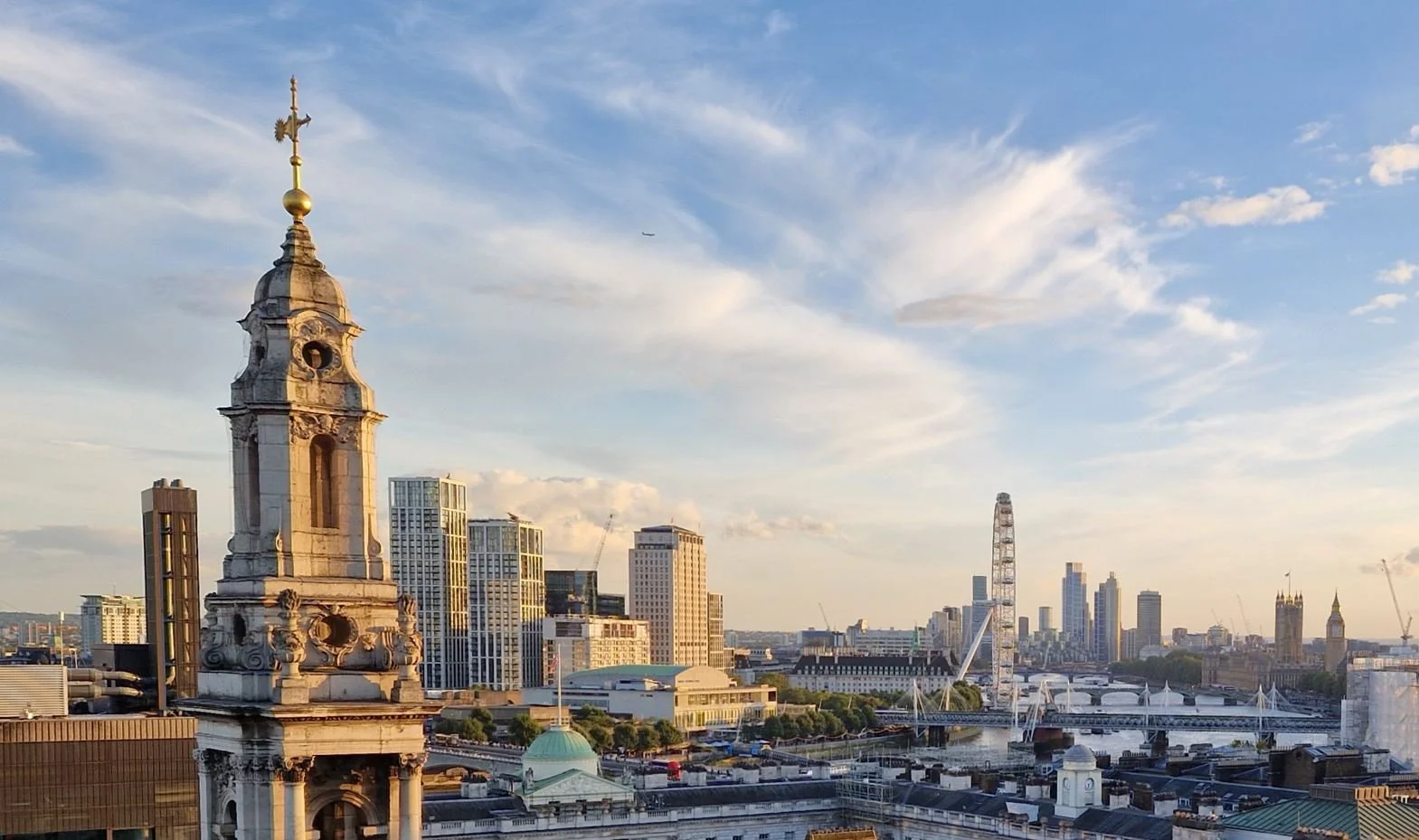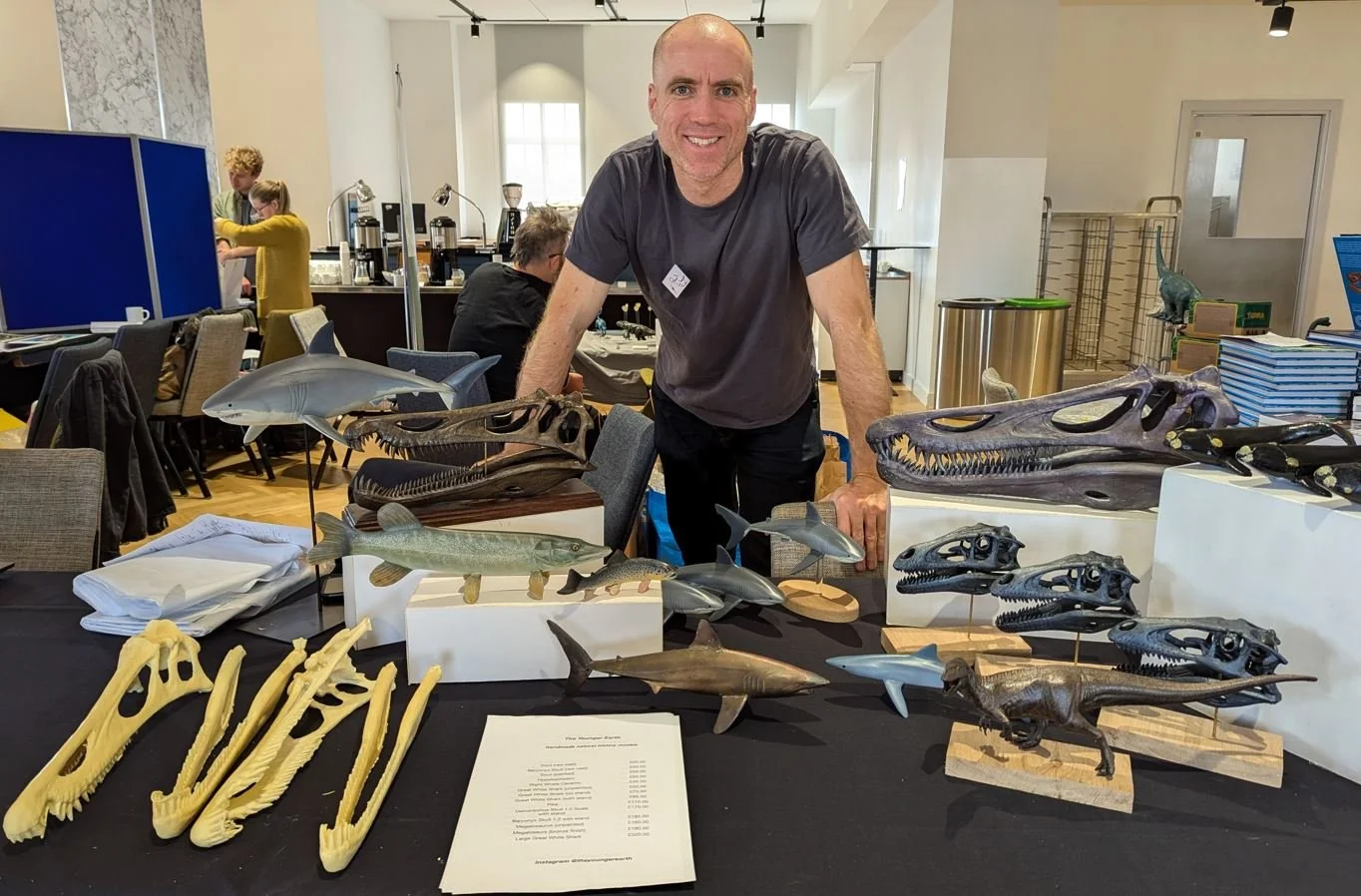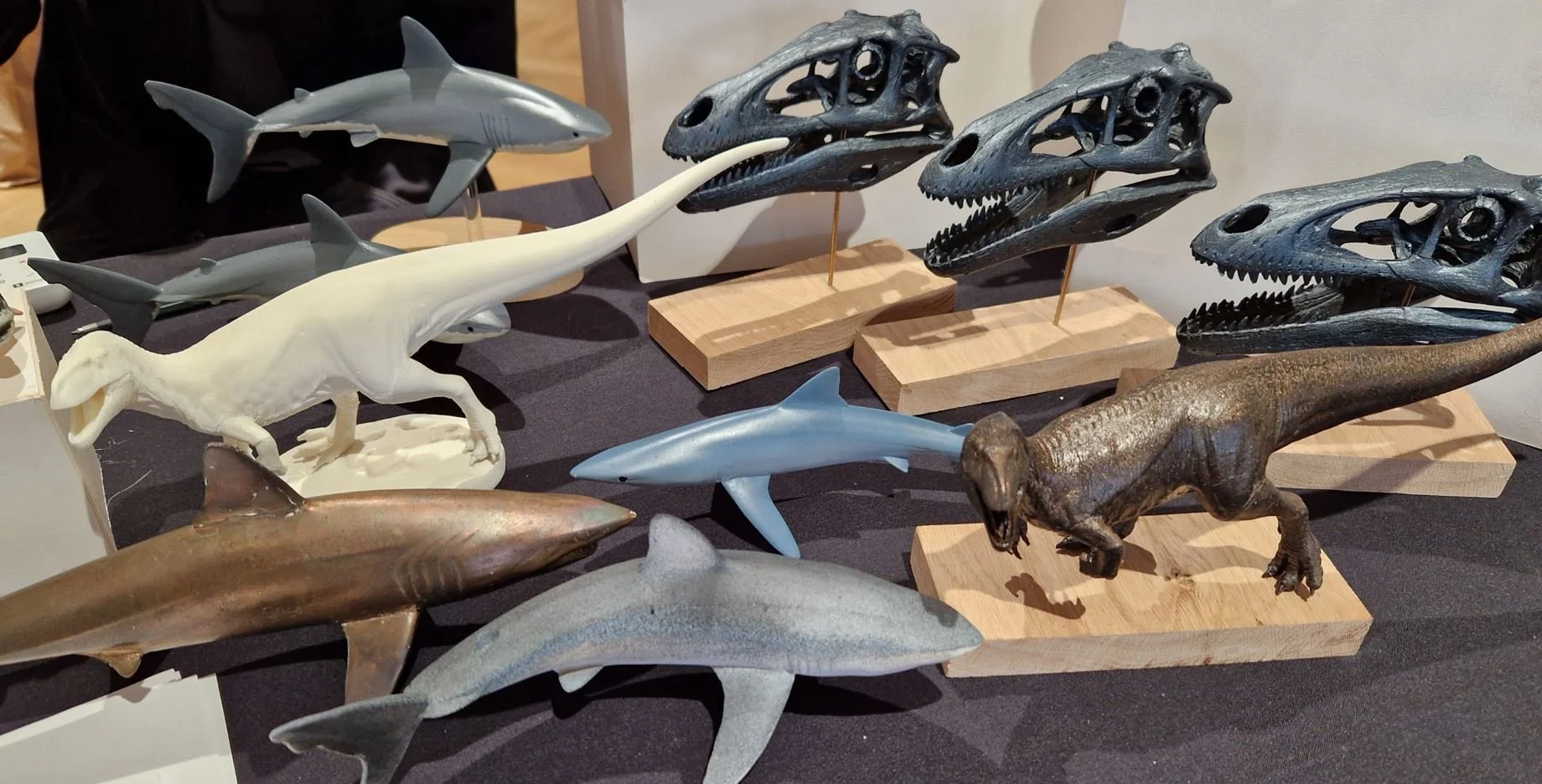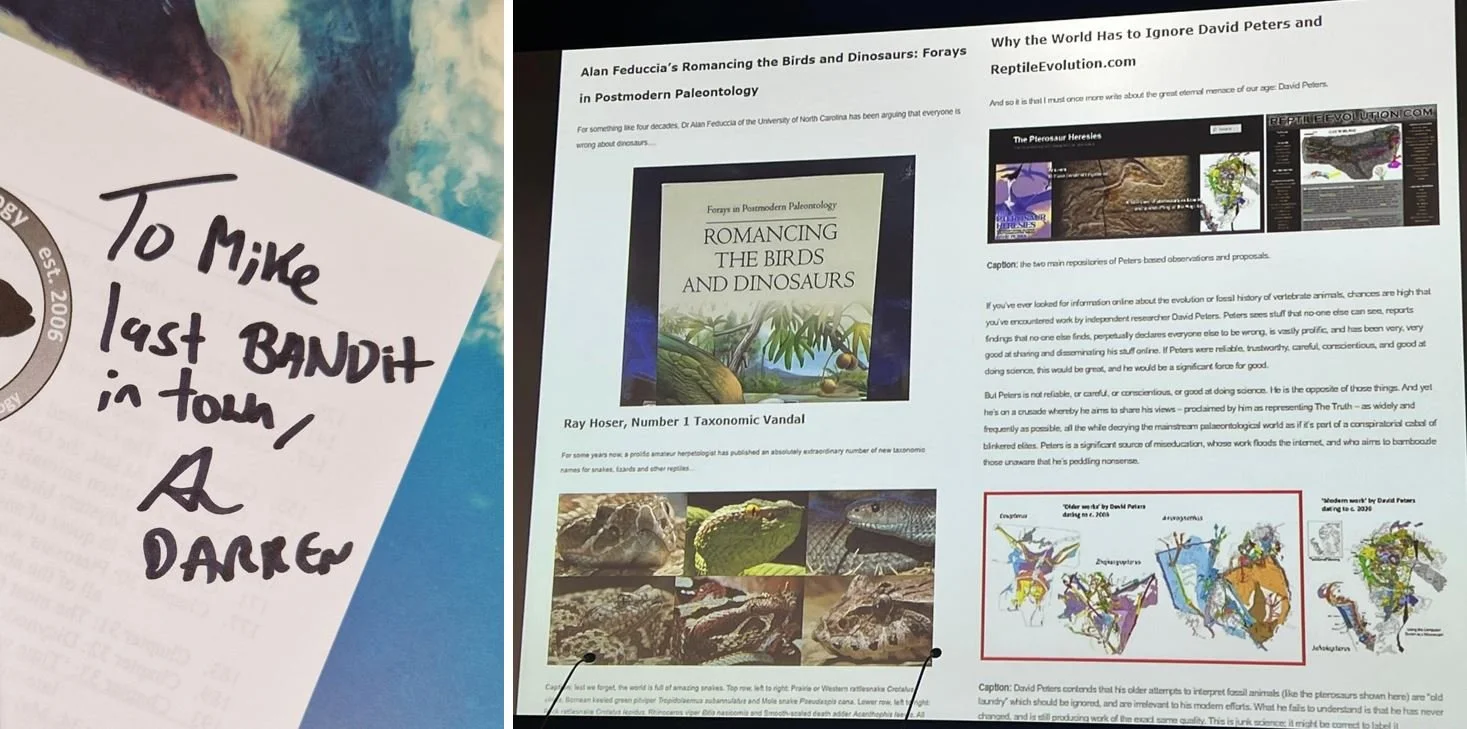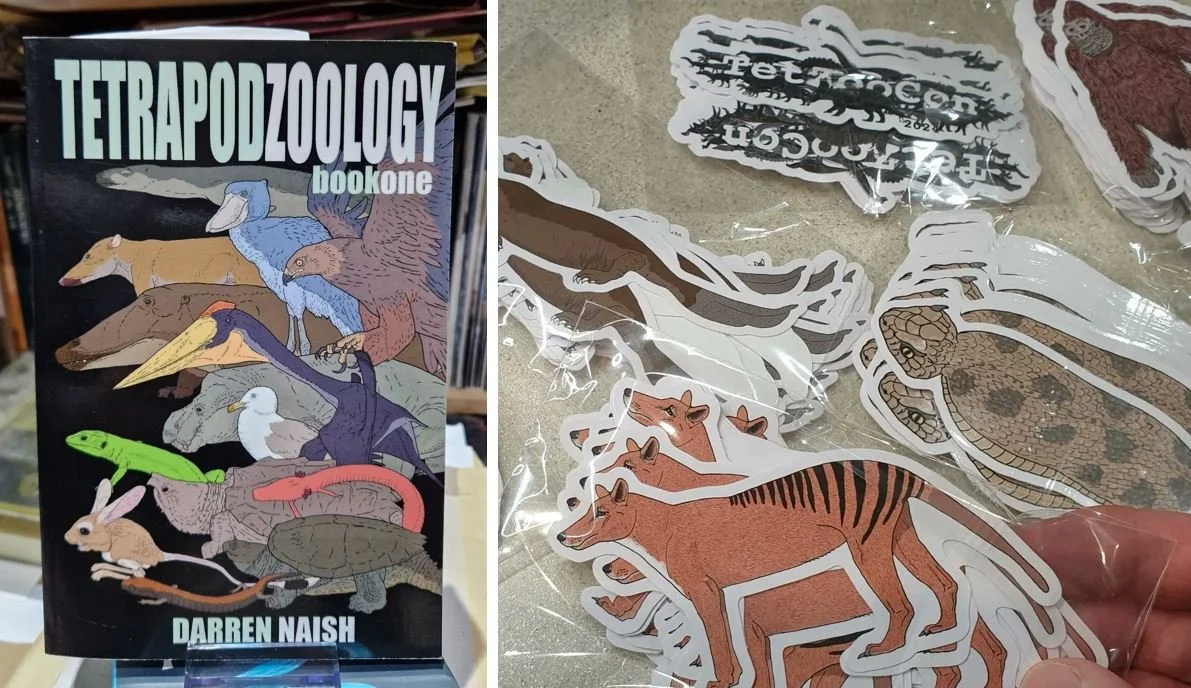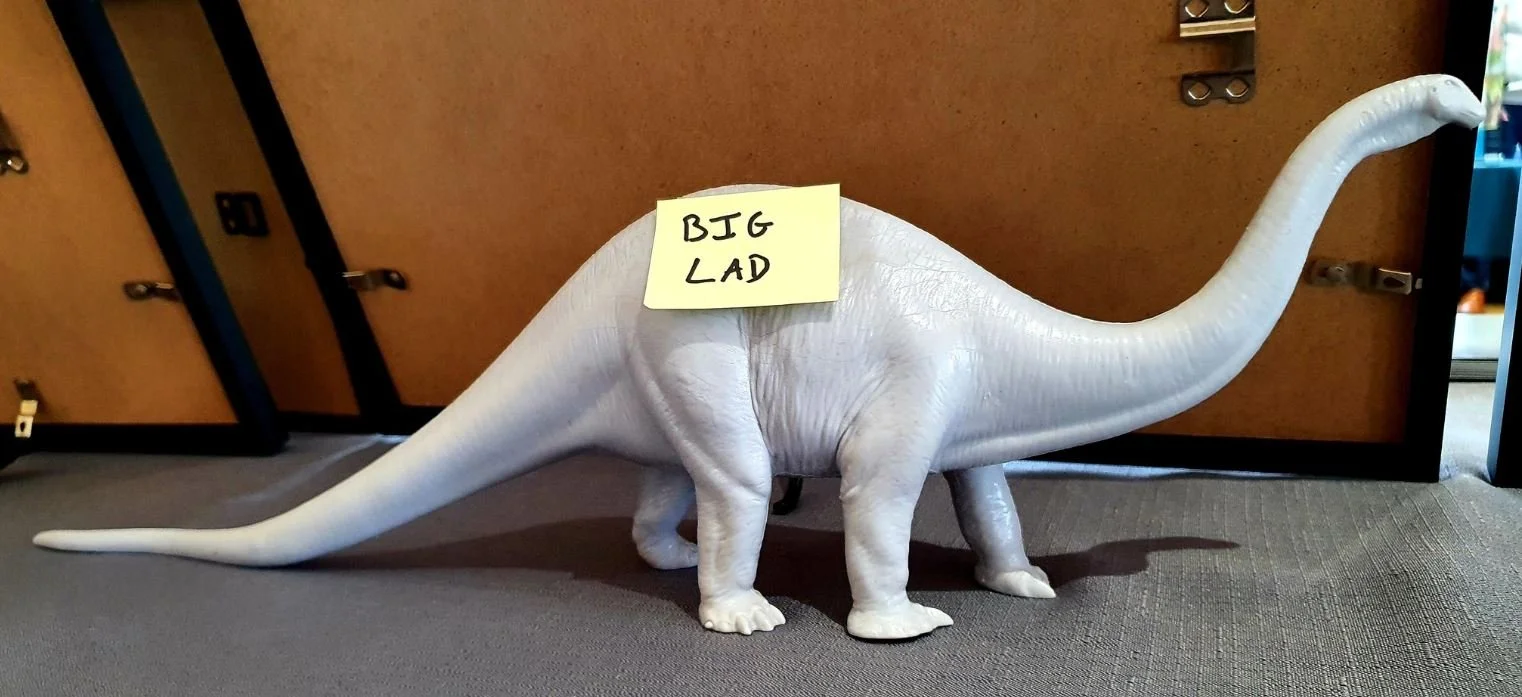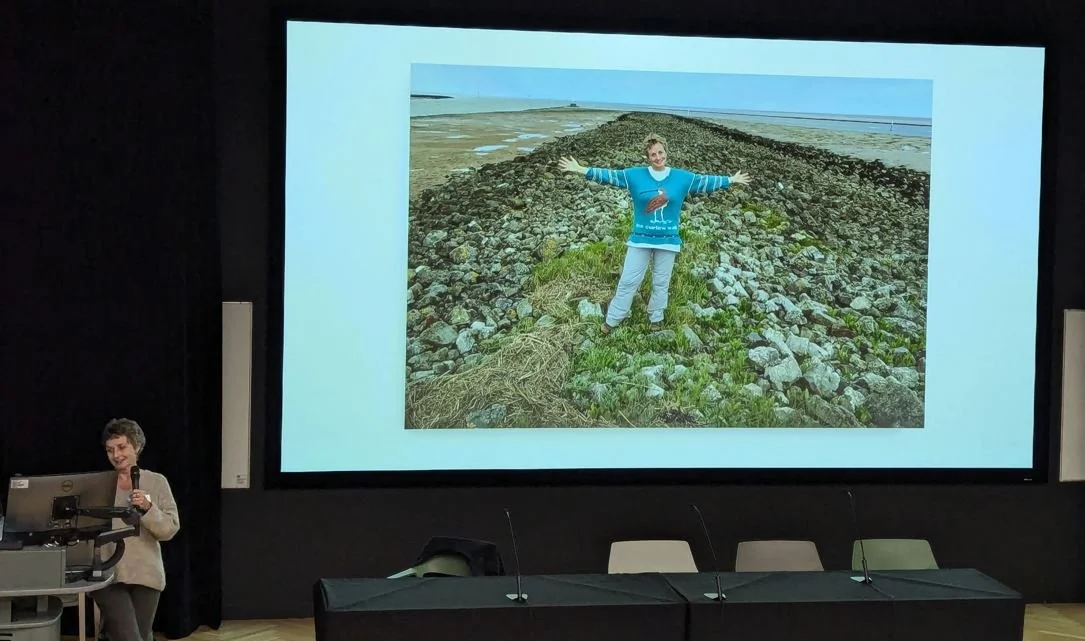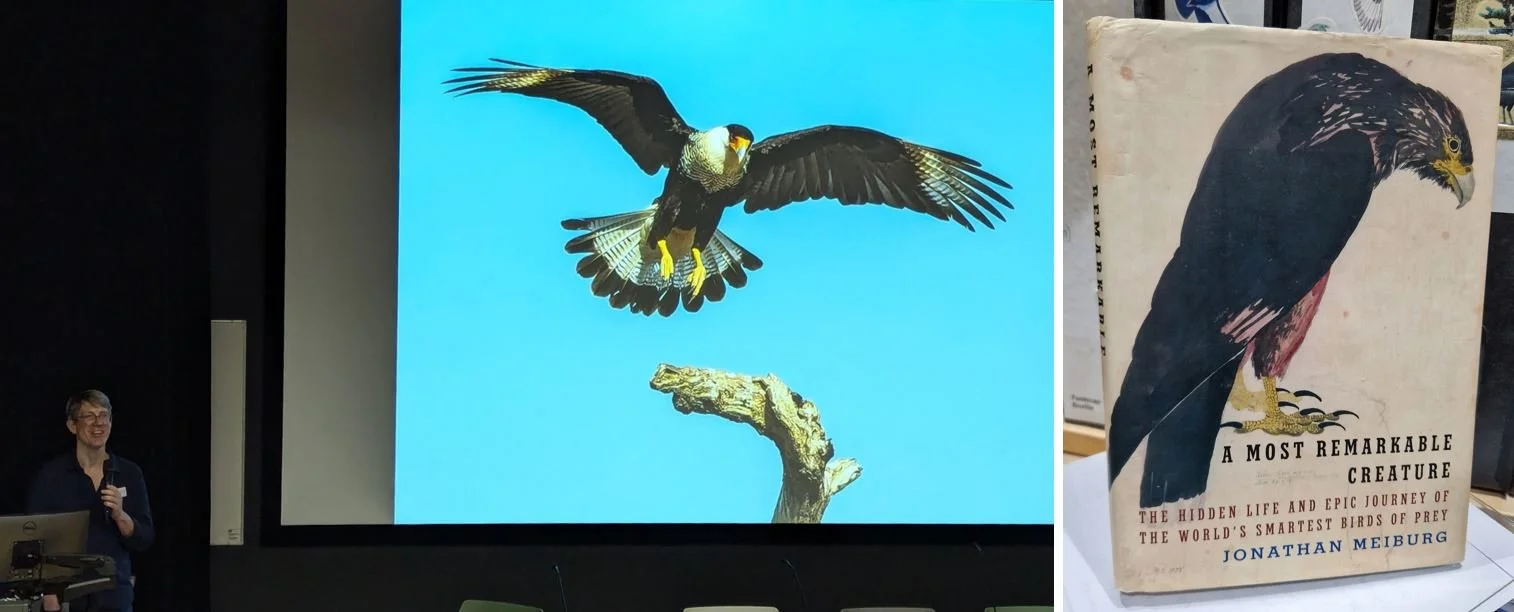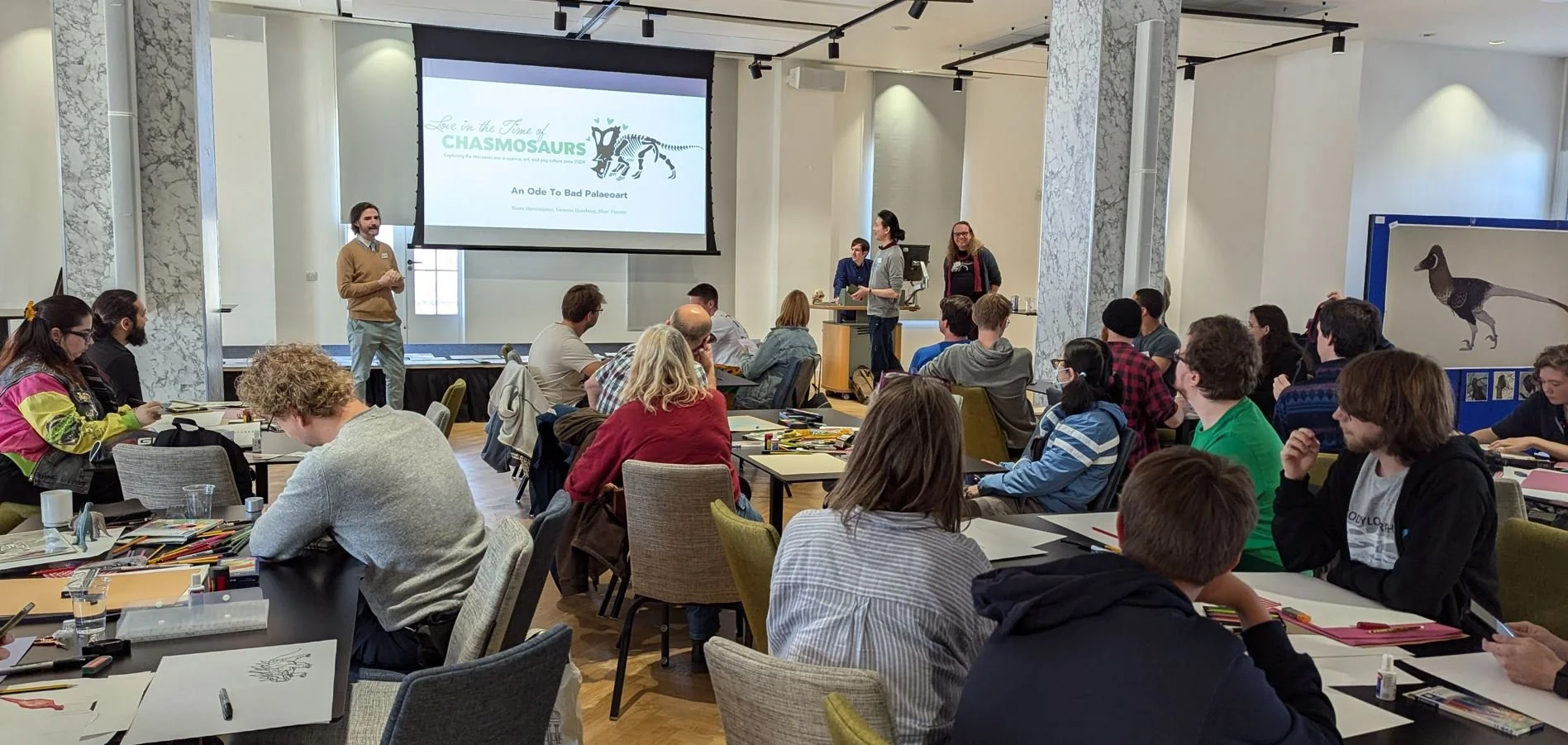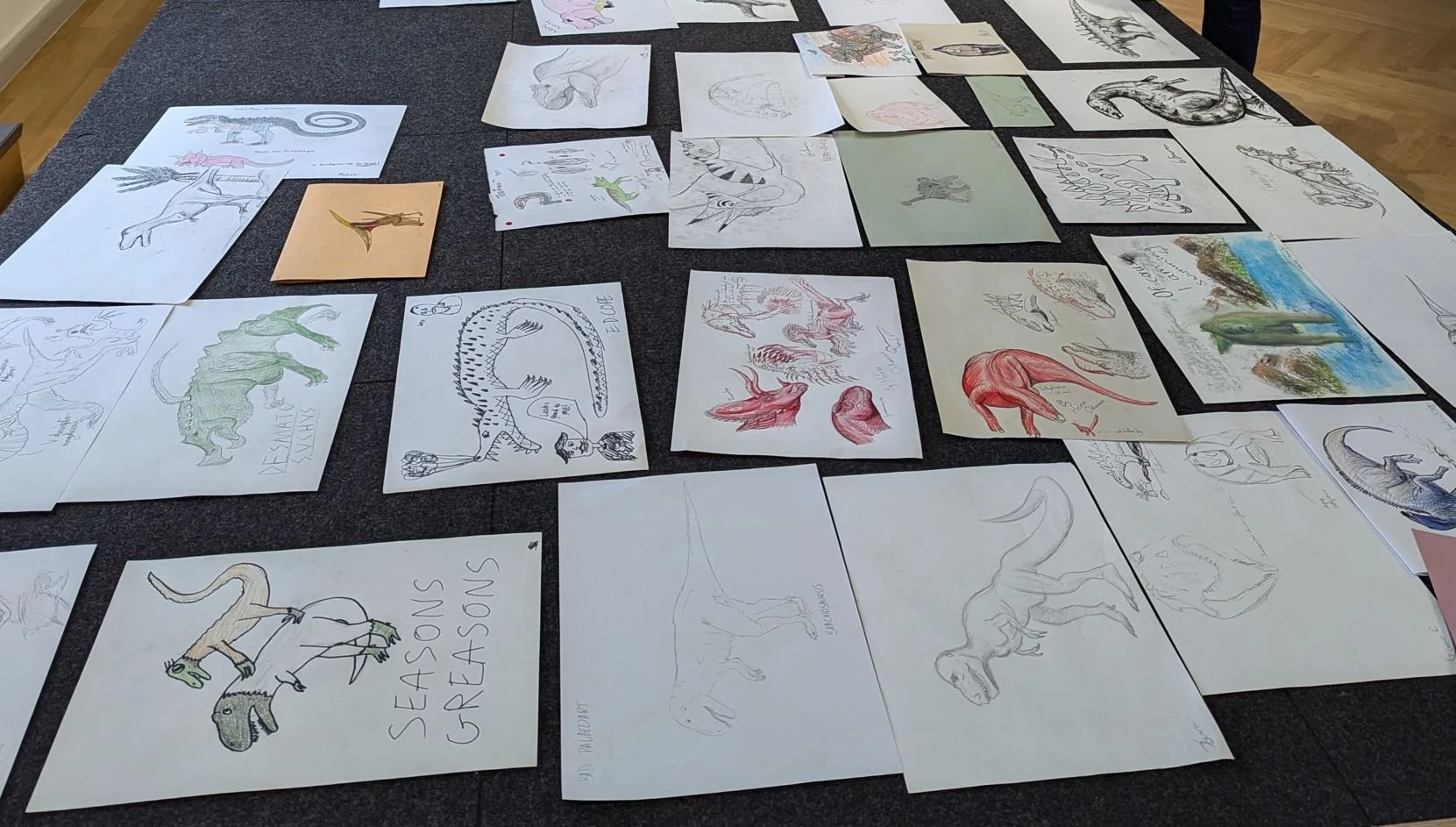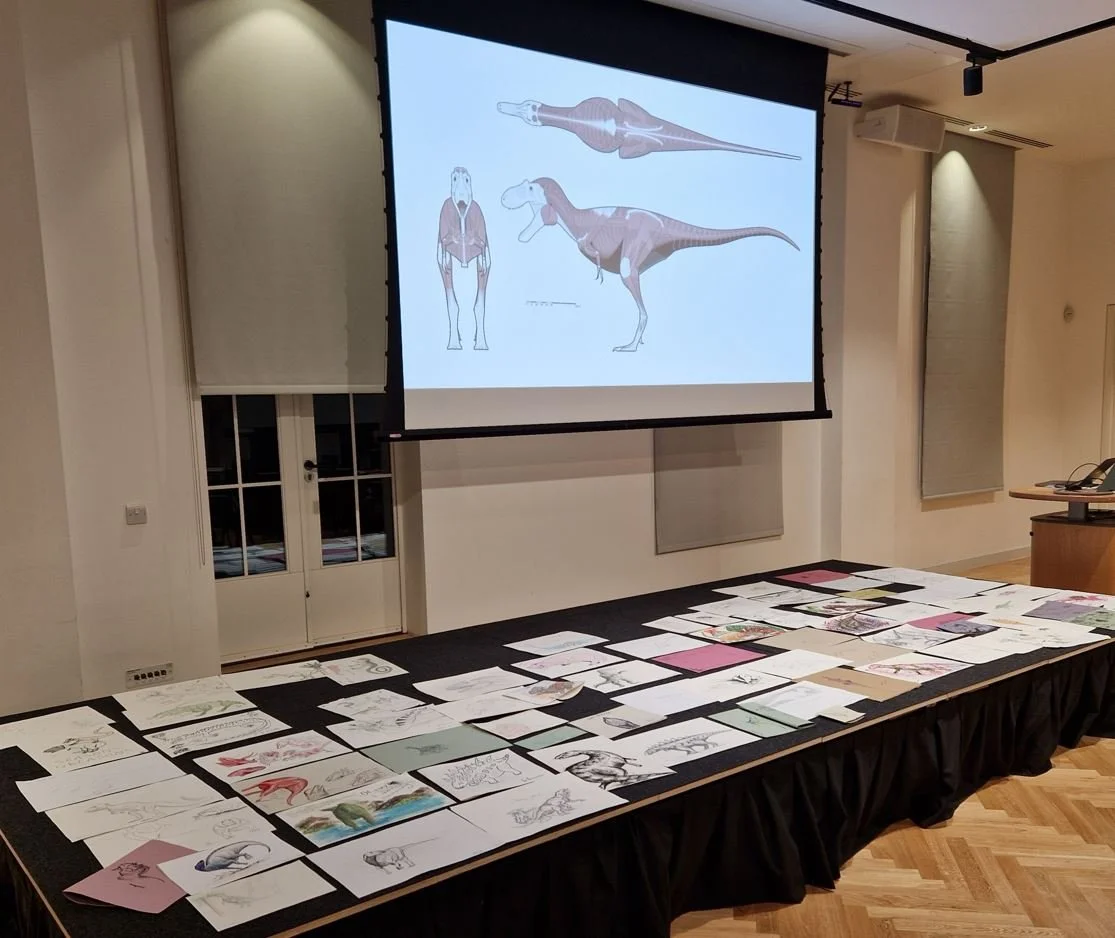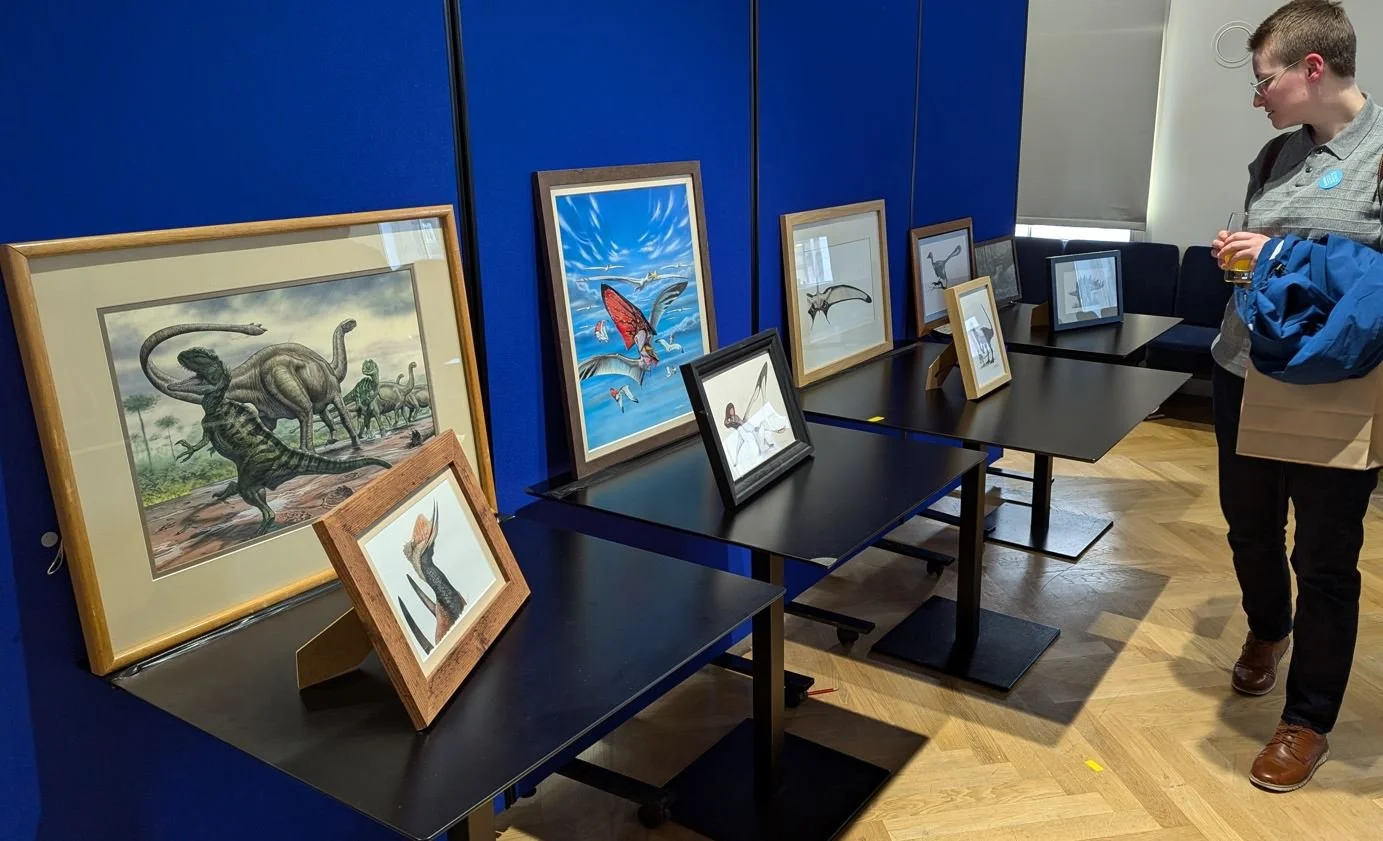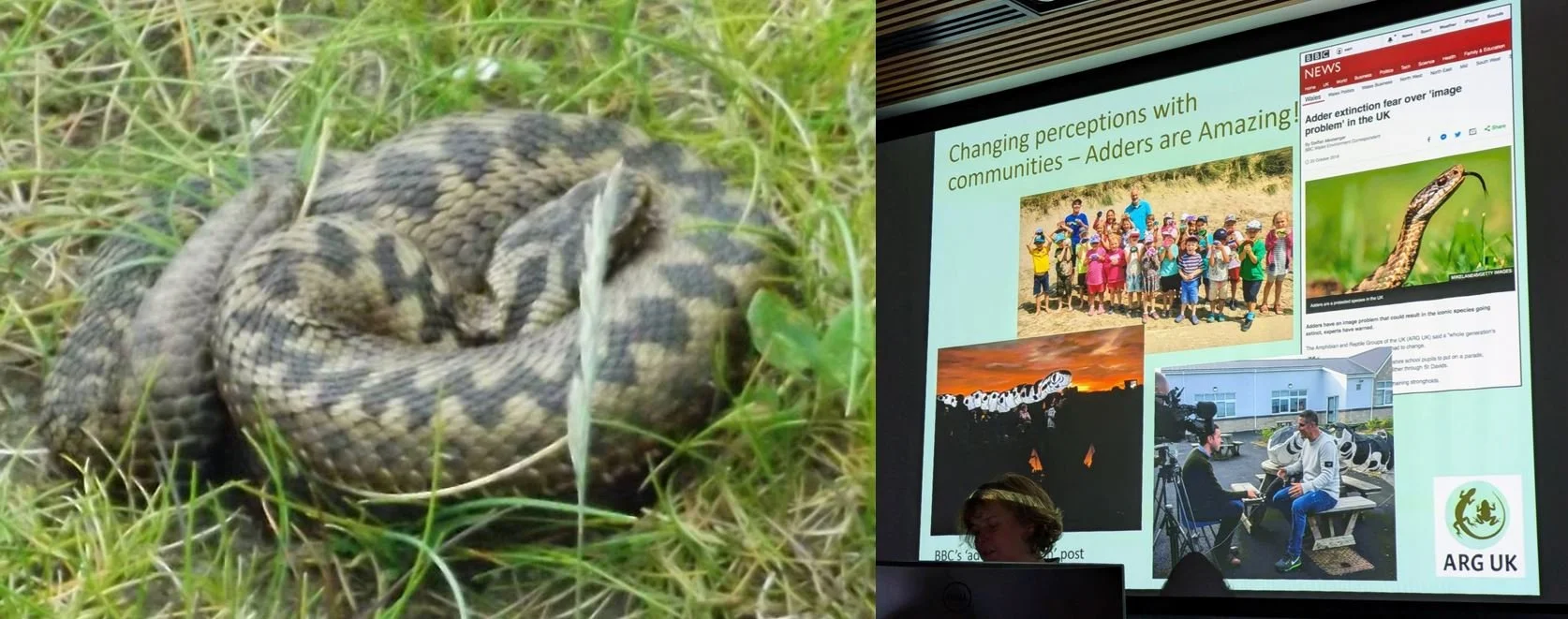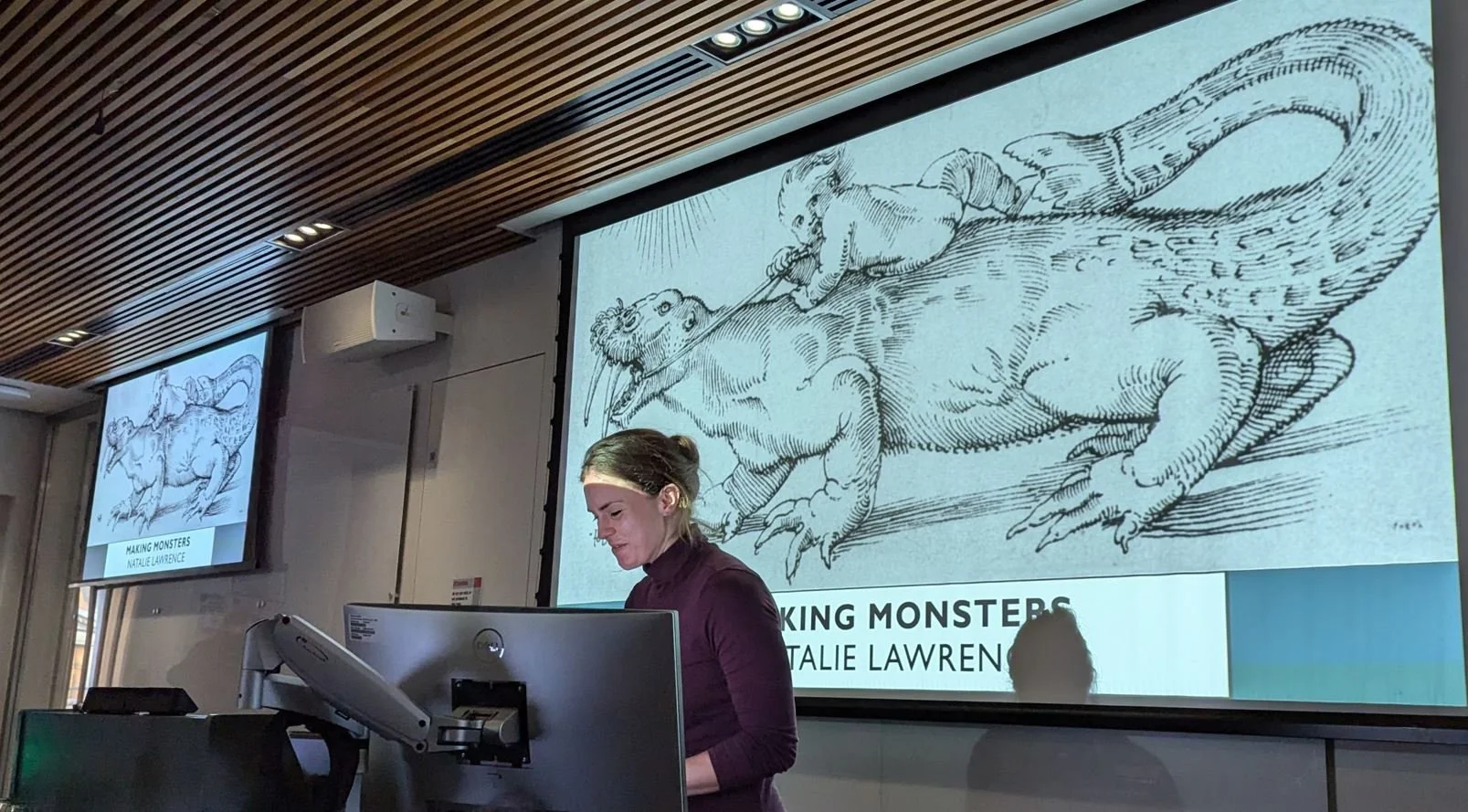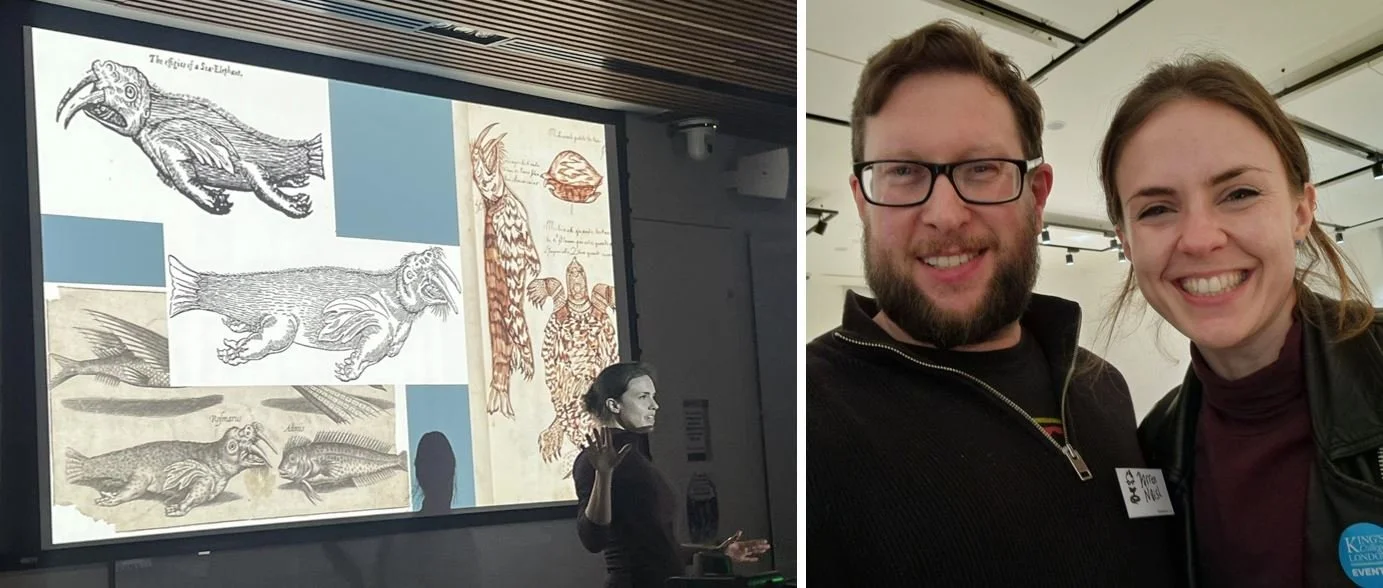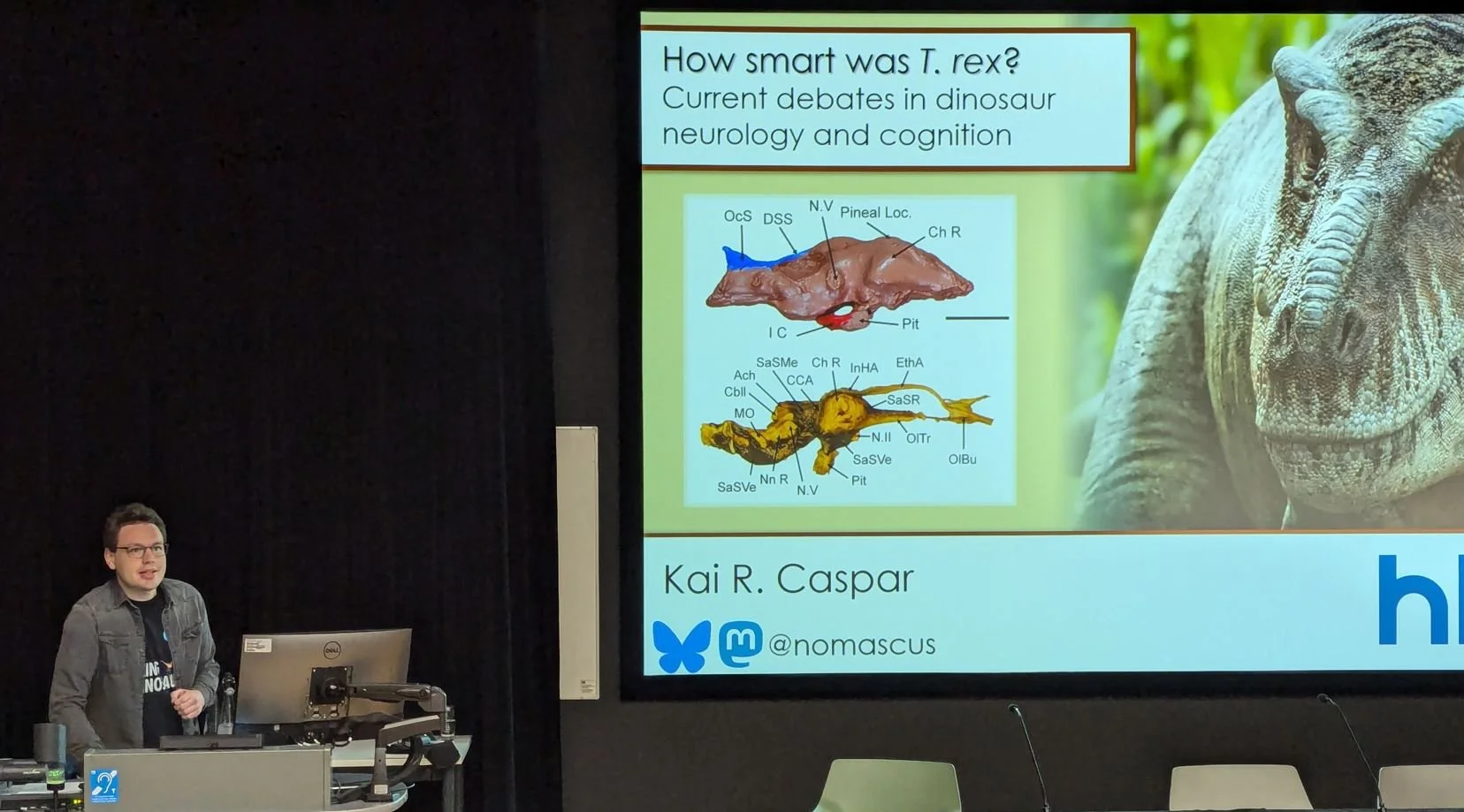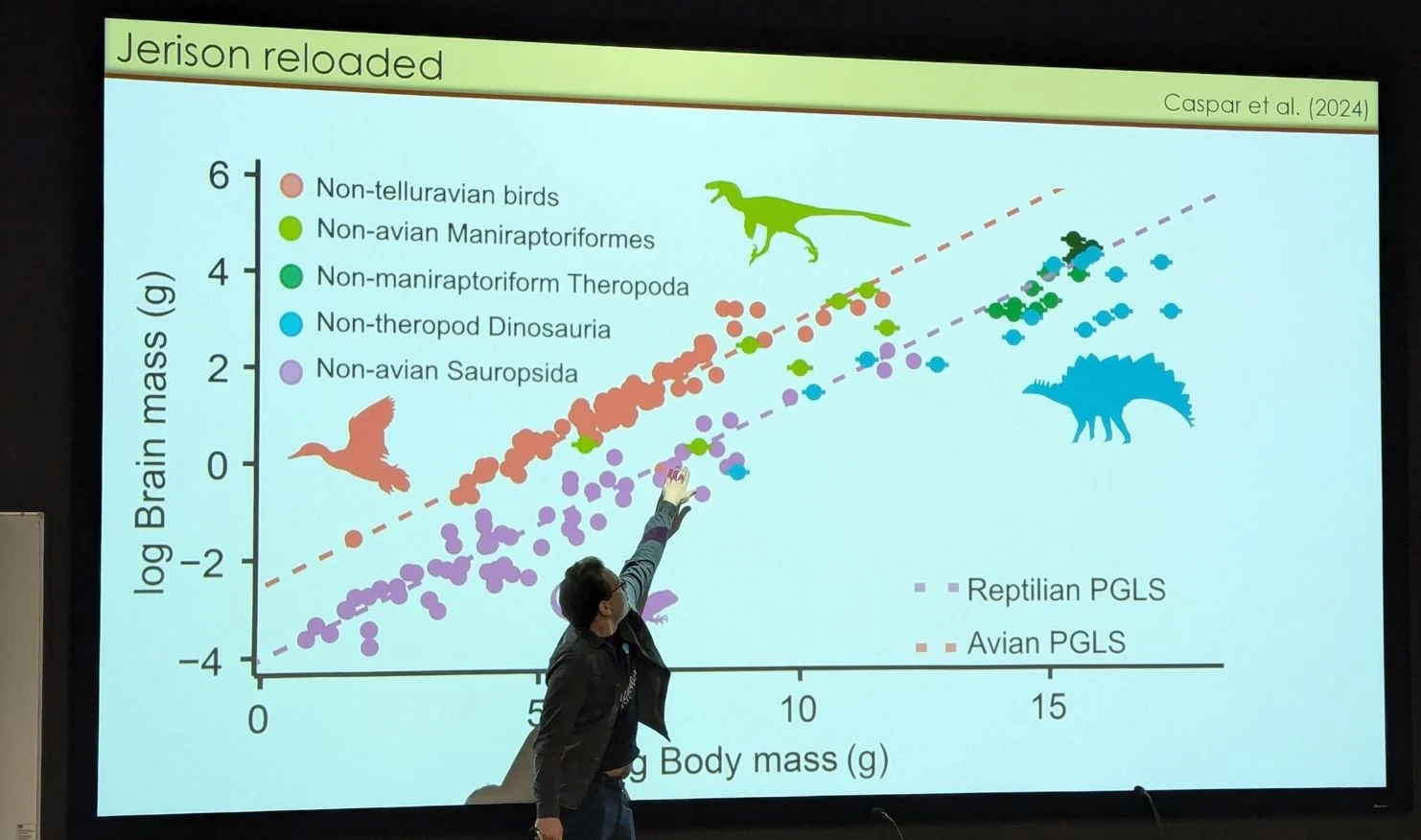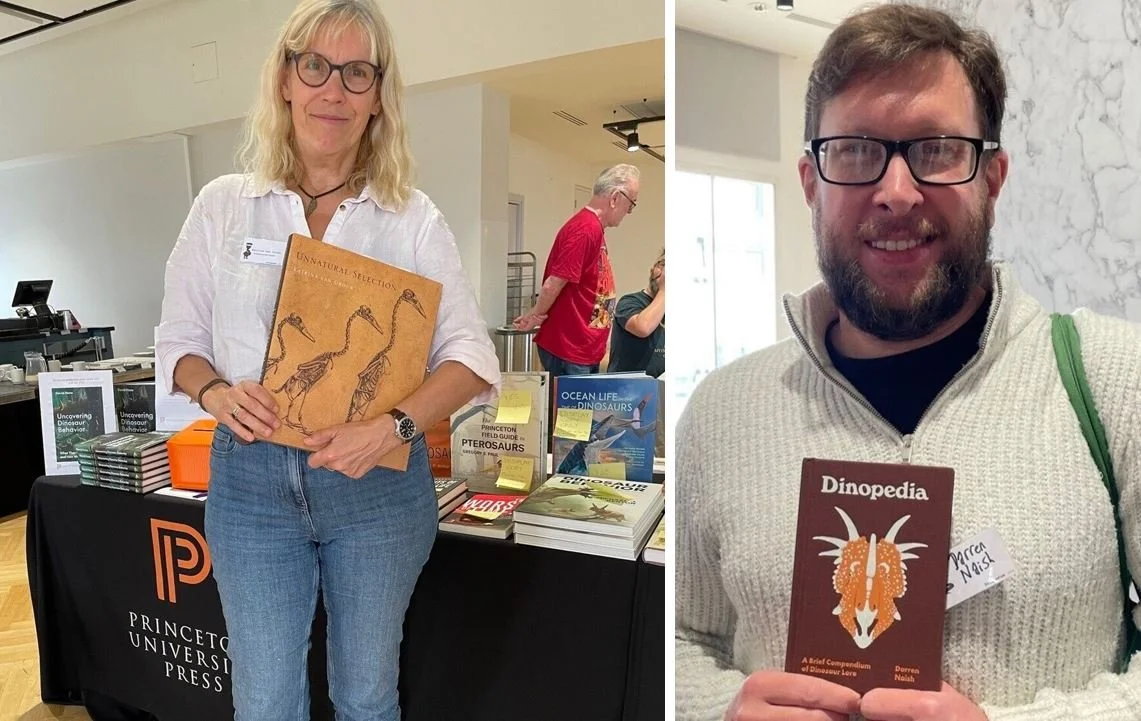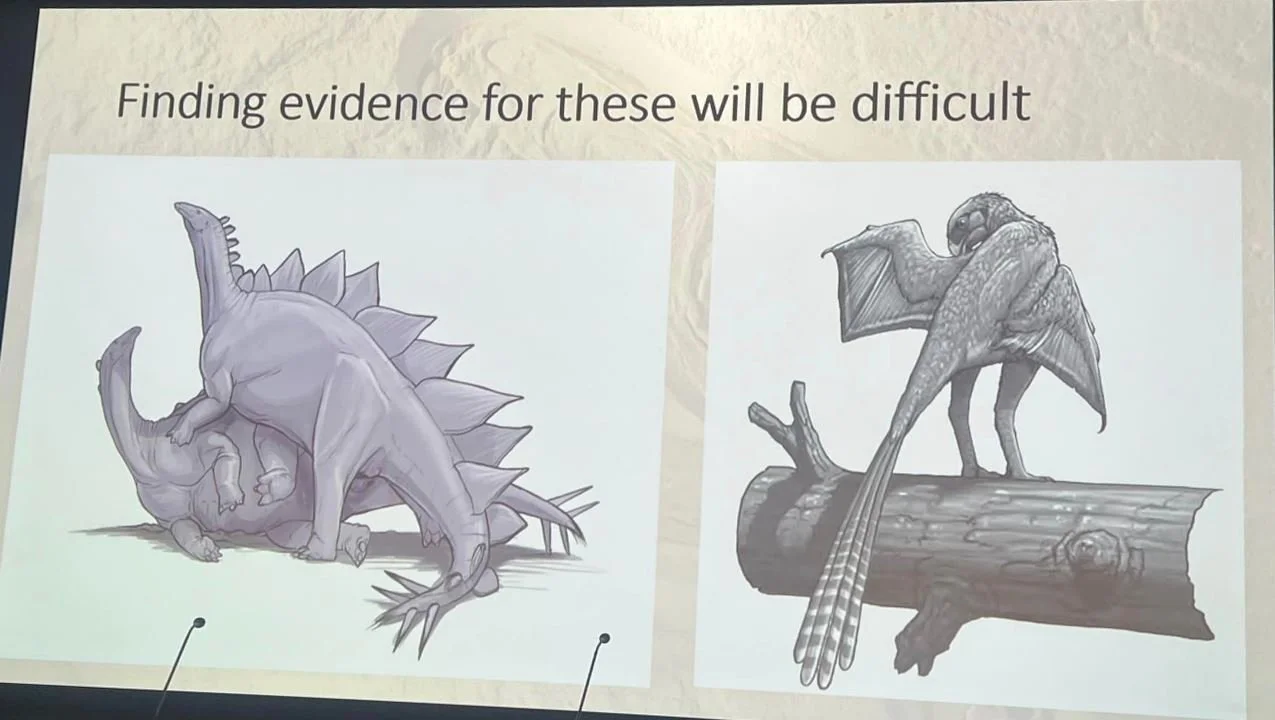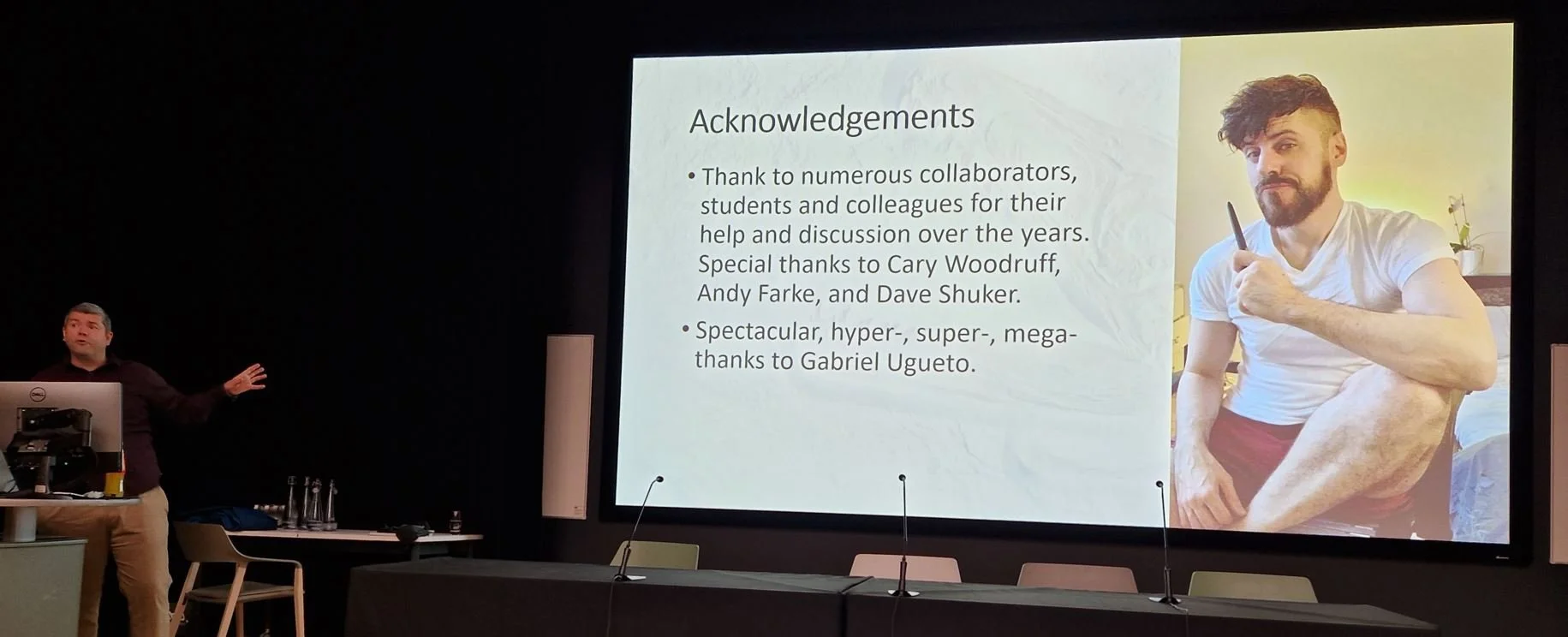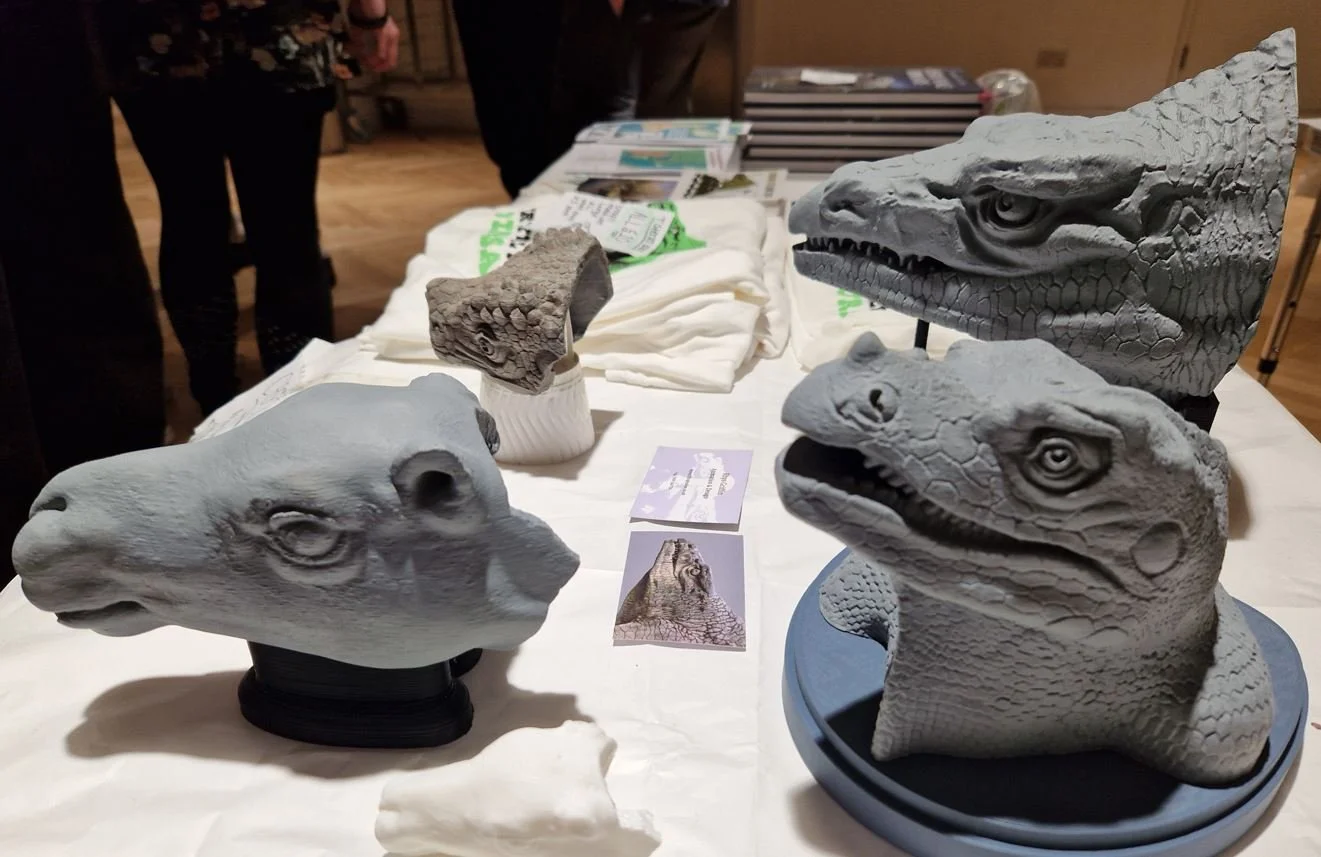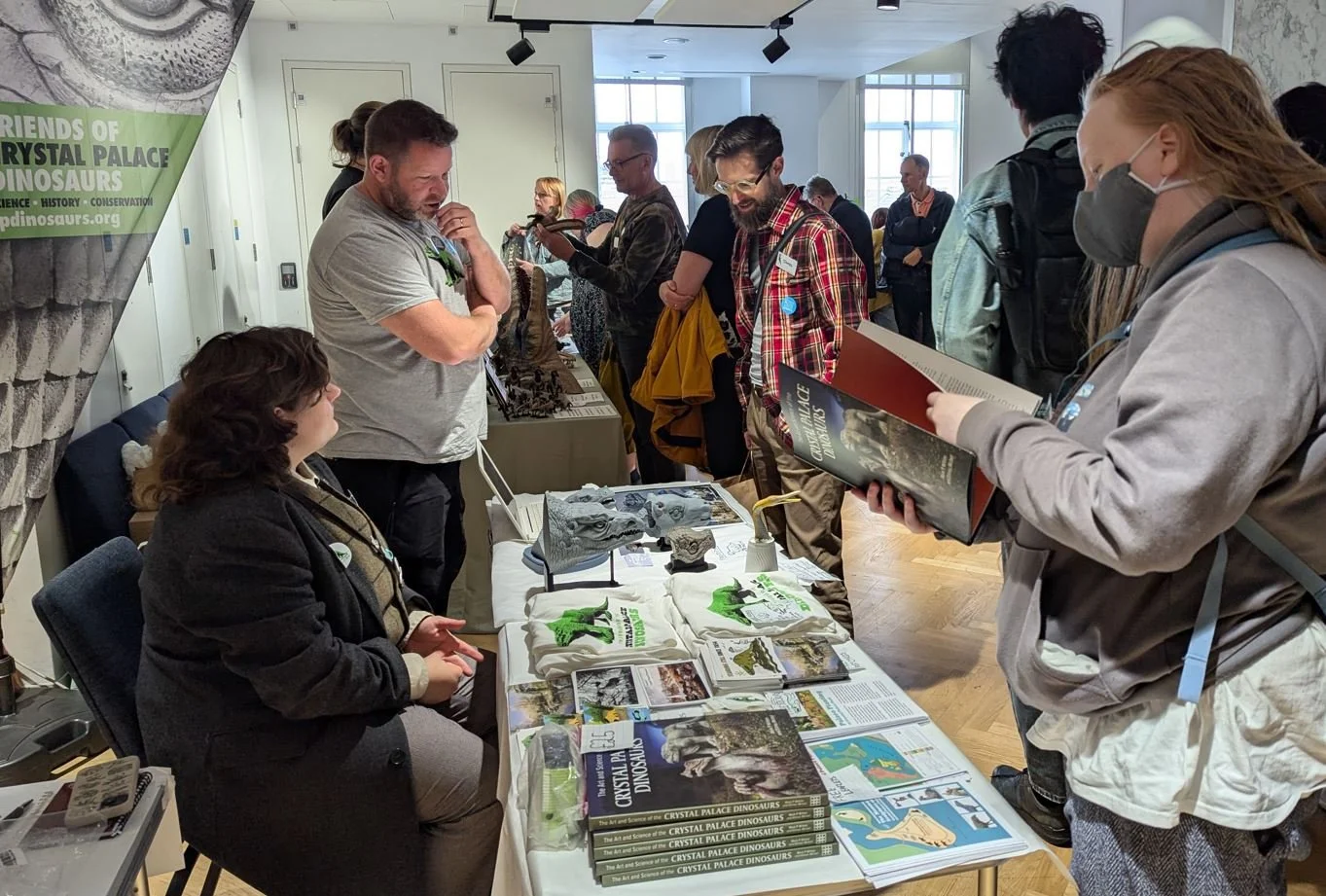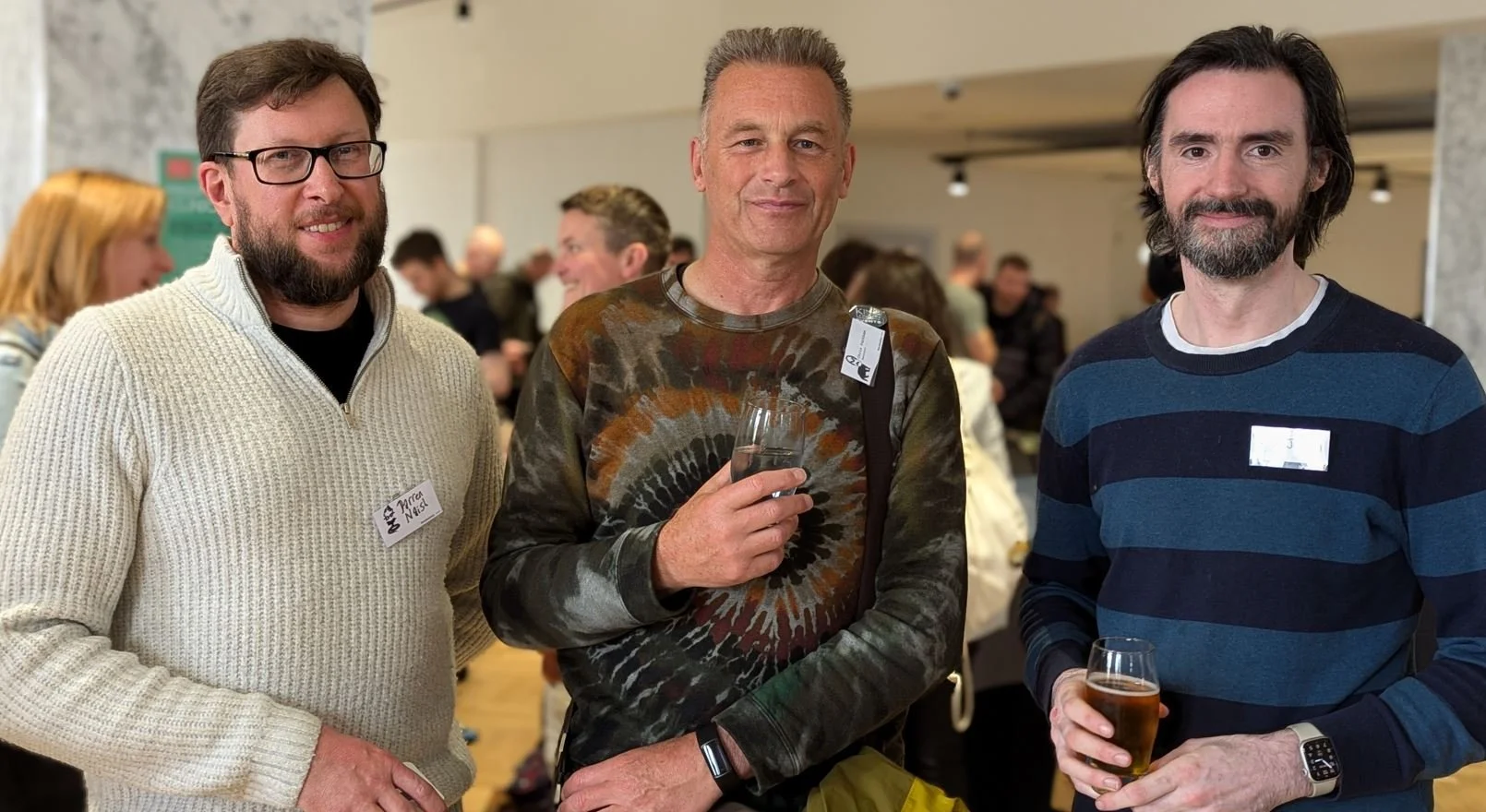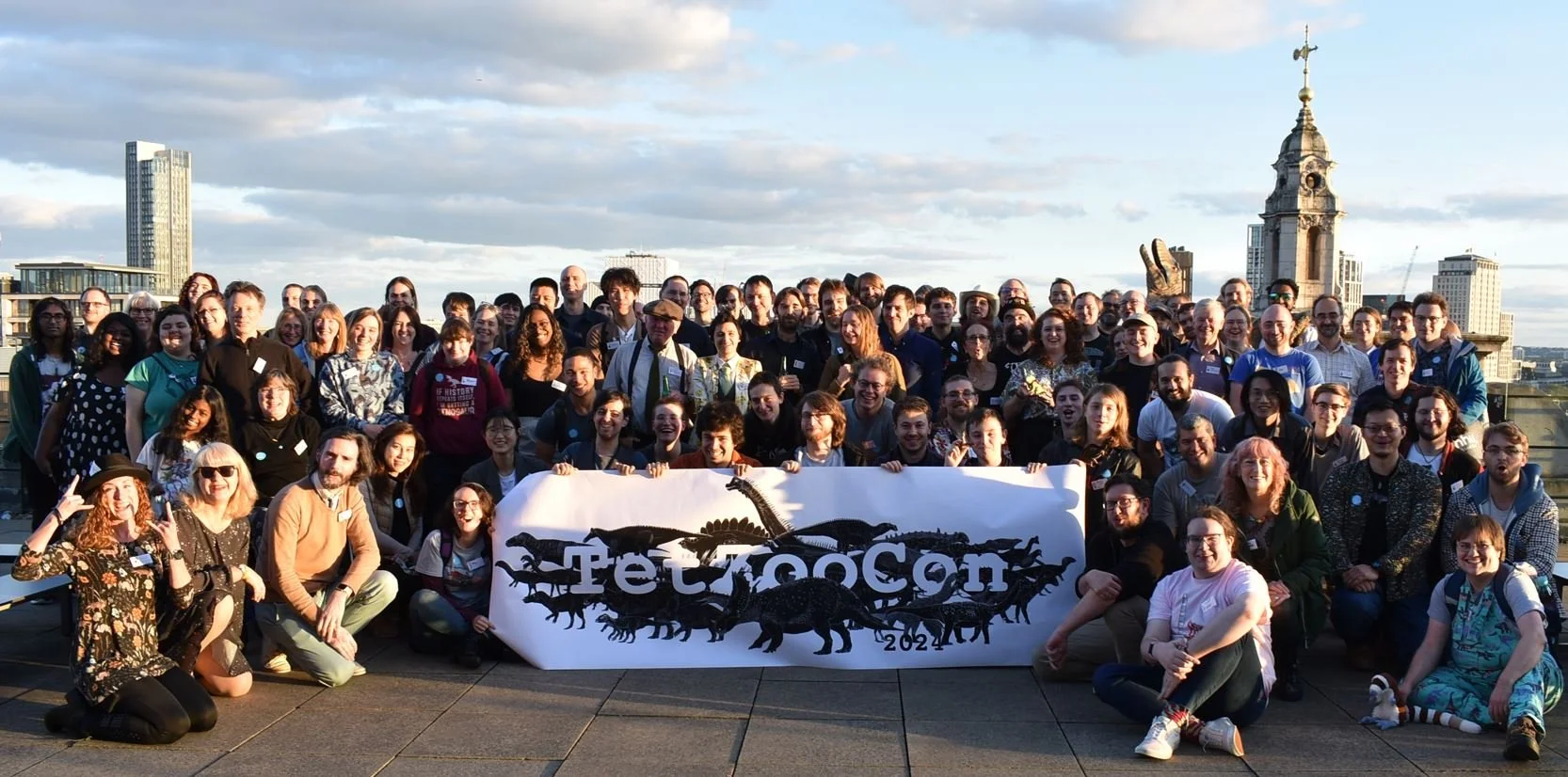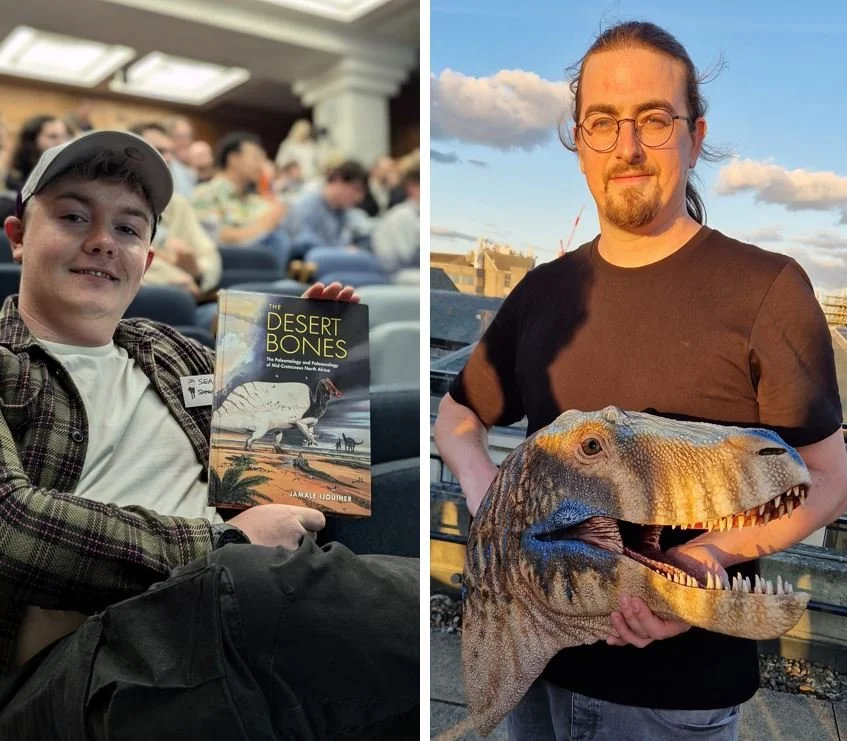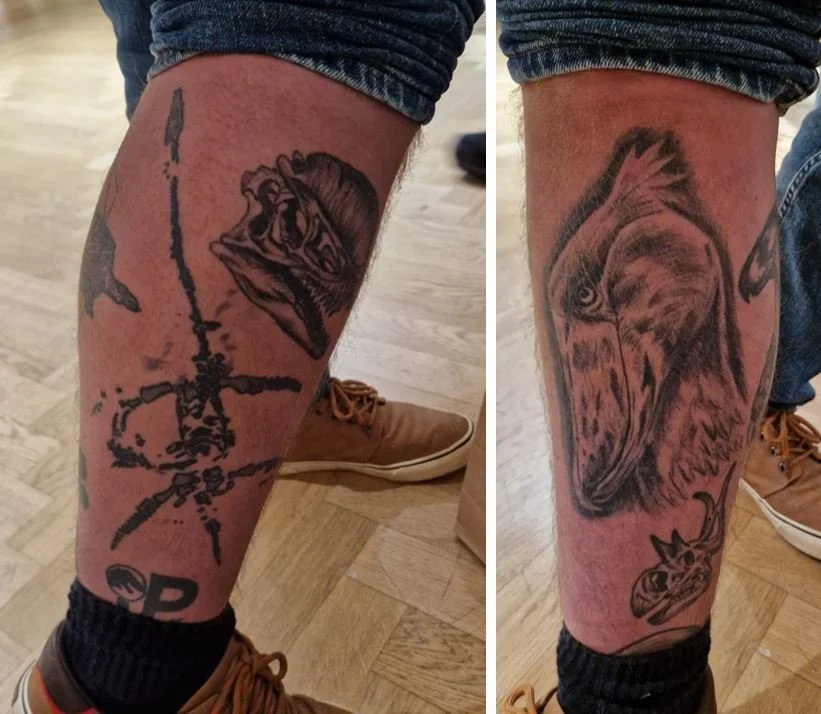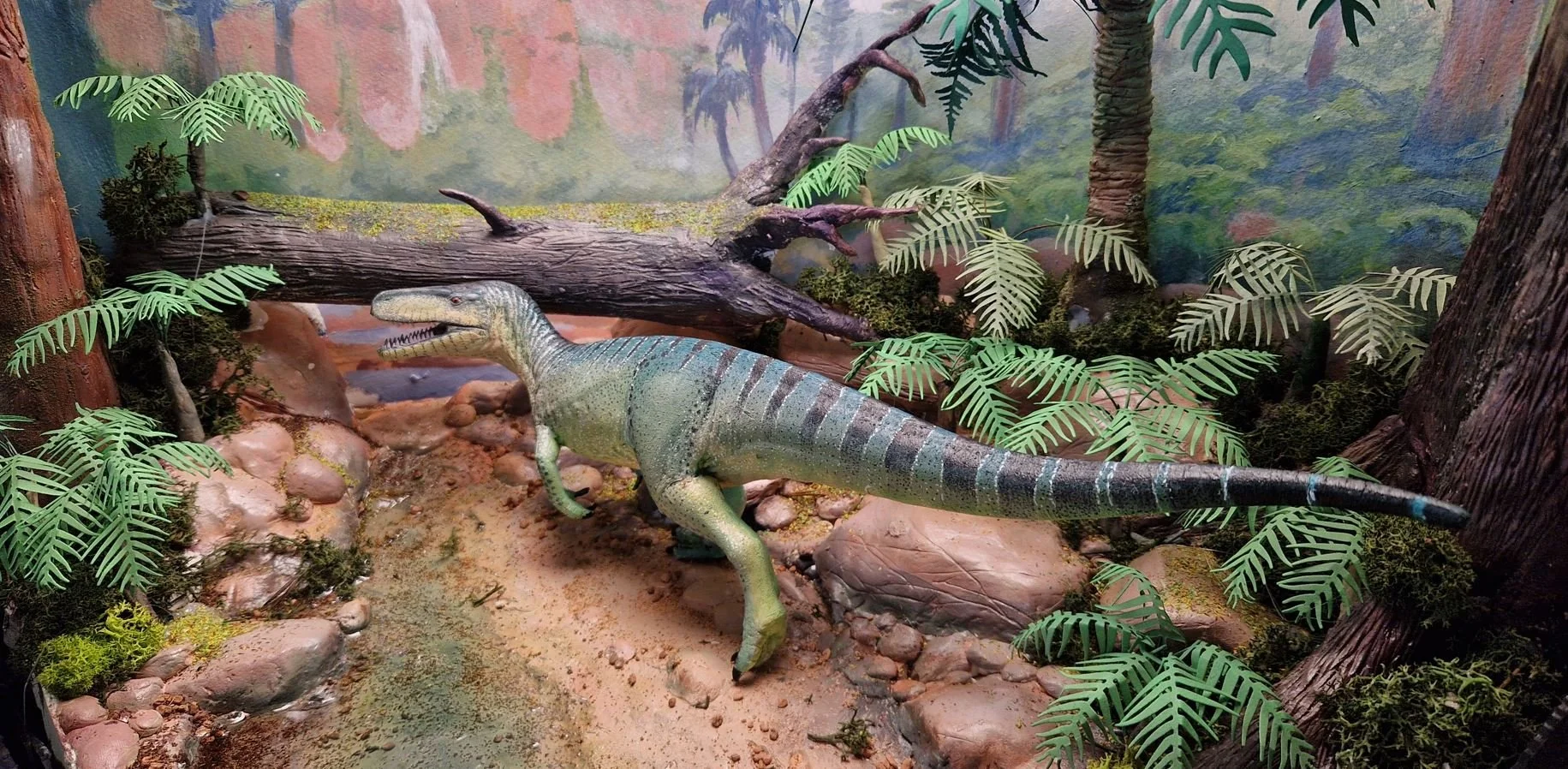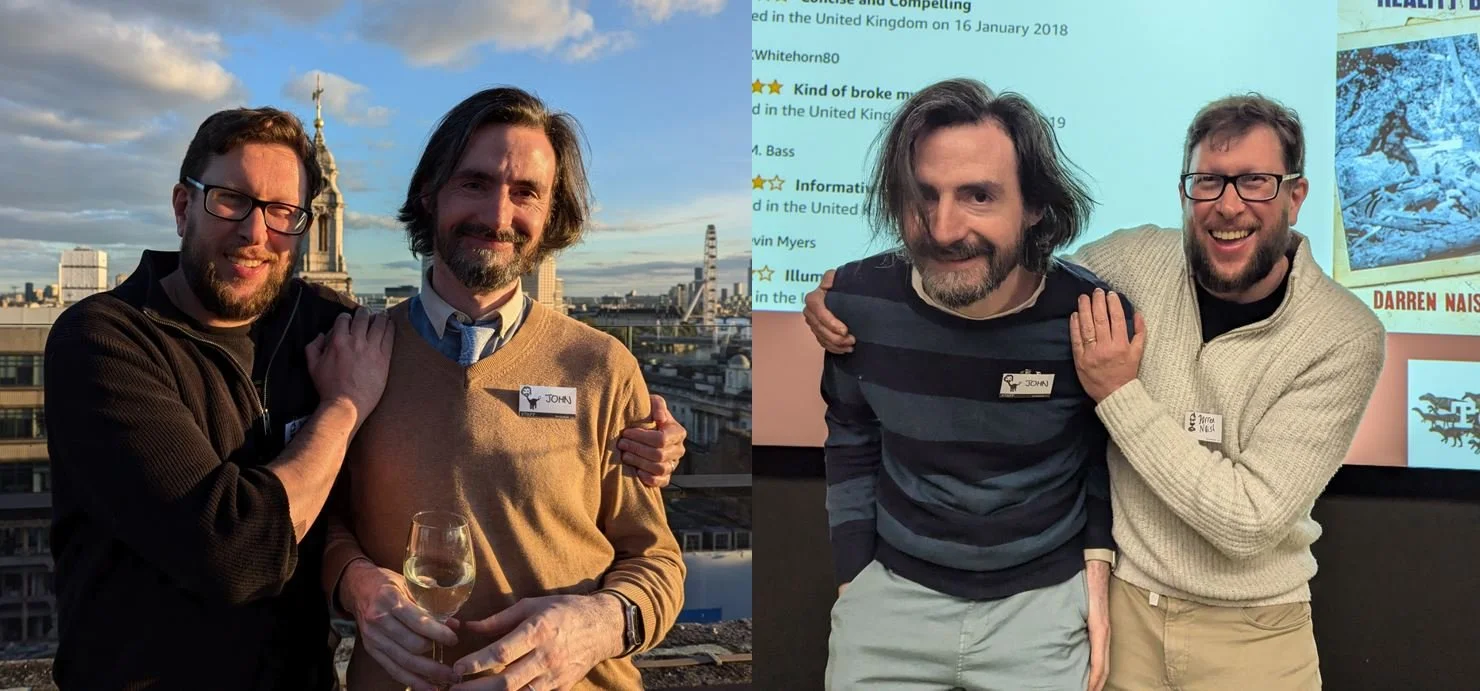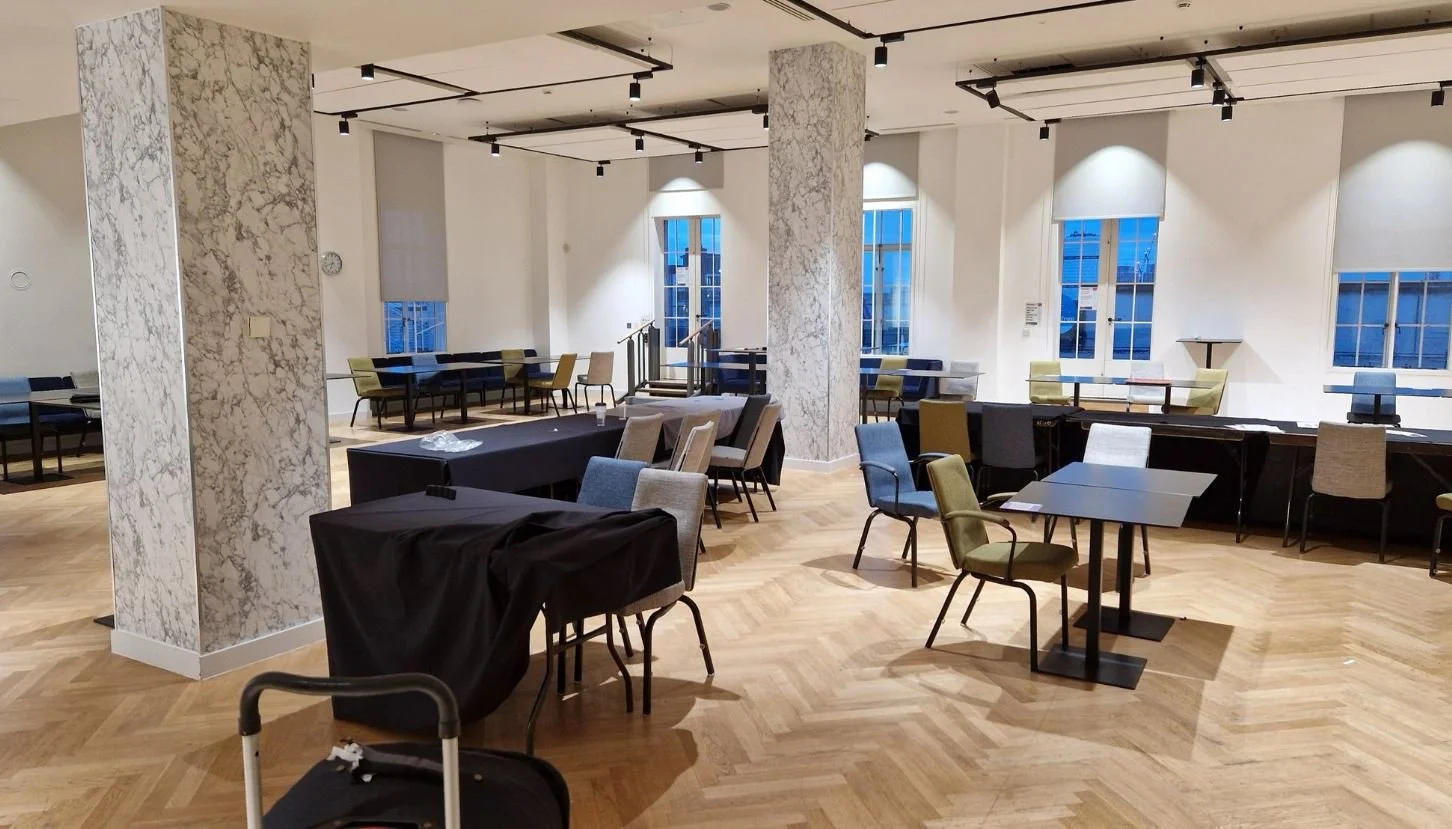Once again, it was recently that part of the year where a good number of science enthusiasts, natural historians, wildlife artists, scientists, researchers and interested members of the public gather in London for what we call TetZooCon: the annual Tetrapod Zoology Convention…
Caption: at left, the front entrance of our venue... Bush House. At right: what's this... DinoCon? Images: Darren Naish; Gemma Hazeborg.
Held once more at Kings College in central London, TetZooCon 2024, the 11th of these meetings, was the biggest and best yet, and perhaps also the most tidily organized and well-run because… oh my god have we learnt from the lessons of the past.
TetZooCon 2024 ran from September 27th to 29th and was co-led by myself, palaeoartist John Conway, historian and author Chris Manias, and a team of helpers and assistants. Our venue (Bush House) provides good-sized auditoriums and lecture theatres, but this year we also won access to two massive and spectacular terrace areas, one of which (the South Terrace) has a balcony with an incredible view of the London skyline. You’ll see what I mean from the photos below.
Caption: the view from the South Terrace was fantastic when the weather and lighting was right. The tower to the left belongs to the (closed) St Mary le Strand church; across the Thames we see the London Eye and the Palace of Westminster at far right. Waterloo Bridge and (further away) Westminster Bridge are visible here too. Image: Darren Naish.
Things kicked off on Friday evening with a drinks reception followed by the on-stage panel event ‘Of Weird Animals, Books, and Publishing’, themed broadly around books and on being an author. I led, and was joined by zoological consultant and author Dani Rabaiotti, researcher and author Natalie Lawrence, and the aforementioned Chris Manias. And that was that for the Friday. I didn’t stay out too late.
Caption: our Friday evening panel event ‘Of Weird Animals, Books, and Publishing’ showing (l to r) Darren Naish, Dani Rabaiotti, Natalie Lawrence and Chris Manias. On the screen behind us are images of various of the books we’ve been involved in: each author is sat close to images of their own book or books. Image: Georgia Witton-Maclean, used with permission.
Doors opened to TetZooCon proper on Saturday morning, and here’s where most of the stalls were set up and made ready for trading. Our stalls were incredible, surely representing the very best in terms of what the UK has to offer in terms of animal- and palaeo-themed merch. Toys, models, pin badges, ornaments, art prints, posters, books and much more were on offer. I signed and sold copies of both Tetrapod Zoology: Book One and Ancient Sea Reptiles (second edition), as well as a large number of animal models.
I don’t want to start talking too much about the stalls because there were many of them and they were all good. But I’ll mention Sam St Leger and his All Yesterdays figures, Matt Dempsey and his army of 3D-printed tyrannosaurs, Carla Owens and her beautifully crafted dinosaurs, pterosaurs and other animals, Paul Glynn and his phenomenal sharks, bronze dinosaurs and ceramic whales, and of course Jed Taylor and Ruadhrí Brennan’s incredible model dromaeosaurids and replica dinosaur skulls. My god there was a lot of great stuff. You know that it’s only going to get better in future… or worse, depending on your finances.
Caption: Paul Glynn of The Younger Earth at his TetZooCon stall, showing his incredible models and sculptures of sharks, dinosaurs, dinosaur skulls, whales and more. I now own that pike and one of the bowhead whales! Image: Georgia Witton-Maclean, used with permission.
Caption: a more detailed view of pieces on show at Paul Glynn's stall. Why couldn't I be born rich? I need me those things. The megalosaur here (the white one at left and the bronze one at right) also exists in beautiful painted form: see below. Image: Darren Naish.
Caption: TetZooCon heroes Jed Taylor (l) and Ruadhrí Brennan, here holding Baby Bruce the Blue Goose, a life-sized juvenile T. rex bust who had a starring role in this year's events. He peered about London town, he consumed a few stall-holders and guests, and he pranced like a bipedal pony in the group photo. This photo was taken somewhere about half-way through TetZooCon, so some of Jed and Ru's wares had already disappeared. Look at the amazing replica skulls (including the pelagornithid or pseudotoothed bird), the magnets at far right, and the model Megalosaurus near the middle. Image: Georgia Witton-Maclean, used with permission.
TetZooCon talks, day 1. On talks and panel events and so on, John and I gave our short, customary welcome and here’s where John dropped – in passing – the bombshell that this was set to be the last TetZooCon. An audible gasp and several wails and sobs rippled through the auditorium. We planned to return to this point right at the end, on Sunday evening. Things then kicked off with my ‘Brian Ford and the Dinosaurs: an Unsuccessful Effort to ‘Make Dinosaurs Aquatic Again’’; the talk might be familiar, albeit entertaining, stuff if you’re followed the conversation, but this time round it’s framed to emphasize how scientists and science popularisers need to constantly work hard to push back against the anti-scientific egotists who aim to subvert society for their own ends. The good news is that quite a few good people are doing this sort of work in the public sphere. The bad news is that there aren’t enough of them in view of the sway the contrarians have and the size of the platforms they keep being given.
Caption: me, with the opening slide of my talk on Brian Ford’s aquatic dinosaur thing. I tweeted about the existence of this talk prior to TetZooCon 2024, and a consequence is that Mr Ford himself piped up in my twitter responses while I was on the tour. Ford’s opening gambit reads “Such sweet, old-fashioned comments. Curious that nobody is courageous enough to admit that every single scrap of scientific evidence substantiates my view”, and things went downhill from there. The relevant twitter thread is here, if you’re interested. Image: Georgia Witton-Maclean, used with permission.
On the subject of contrarians, some of you will know that – when giving the Ford talk at another recent event (2024’s Symposium on Vertebrate Palaeontology and Comparative Anatomy at the University of Southampton) – I was challenged, in the Q&A following my talk, by a researcher who objected to my characterisation of Alan Feduccia as a ‘contrarian’. I responded by arguing that Feduccia sure the hell is a contrarian, and that this isn’t just due to his apparent lack of familiarity with data but, more insidiously, to his wilful use of unsound argumentation. Check my review article on his book Romancing the Birds and Dinosaurs for full explanation of that.
Caption: at left, a signed copy of Tetrapod Zoology: Book One, sold at TetZooCon 2024. At right, a slide from my talk that brings attention to Tet Zoo articles I’ve published on specific contrarians. Images: Darren Naish (l); Finn Holmes-Kellett.
Palaeoart no, podcast yes. Some of you will know that palaeoartist Greg Paul was scheduled to talk at TetZooCon 2024. Greg has been a formative person in the careers of both John and myself, and it seemed right to have him attend. But, no, it didn’t work out due to illness. Once we learnt of this, we aimed to book other historically significant palaeoartists, namely Doug Henderson, Mark Hallett and Mauricio Anton. All plans fell through for one reason or another.
Caption: several photos taken during the podcast record have a more chaotic or active air than this sedate one, but here’s Darren Naish and John Conway talking stuff. The audience was supposed to tell me to stop when I was droning on too much but they spectacularly failed in this endeavour. Image: Georgia Witton-Maclean, used with permission.
In the end we filled the space with a live record of a podcast episode that included a bit of audience participation and some discussion of the crossover between dicynodonts, South African rock art and the contents of Cryptozoologicon Book One. The relevant episode (# 94) will be released sometime soon. Oh, for the podcast back catalogue go here.
I led one final event: a Prehistoric Planet discussion, this time focusing on the science and backstory to the Badlands episode of season 2. If you were still listening to my voice by this point… boy, are you a sucker for punishment. After lunch, some people perused the stalls some more but a bird-dominated talk session happened, as did the first of our Palaeoart Workshops. The latter were held in the grand, spacious North Terrace. What a contrast to the cramped, sometimes windowless, rooms we’ve had to occupy in the past.
Caption: a big surprise for me was how popular my 2010 Tetrapod Zoology: Book One turned out to be. All copies sold. So maybe I should buy more and repeat this. At right, I also sold cryptid-themed stickers, and they sold well too. Images: Darren Naish.
Caption: over the years, I’ve grown fatter and richer by selling Invicta dinosaur models to (soon to be Dr) Matt Dempsey, and this year we both benefitted by my selling of this fine Invicta Apatosaurus. Matt has awarded it a name and clearly likes it very much. Image: Matt Dempsey.
The modern bird session. On to the bird talks. An excellent and inspiring talk – Curlew Conservation - A Battle for Hearts and Minds – was provided by Mary Colwell. Mary is almost certainly the most decorated person we’ve hosted as a speaker at TetZooCon and in fact was awarded an additional accolade – the ZSL Silver Medal – literally the day before speaking.
Caption: Mary Colwell talks curlews and her discovery of how bad things are. As explained in her 2019 book Curlew Moon, she found that urgent action was required. Image: Georgia Witton-Maclean, used with permission.
The plight of the Eurasian curlew Numenius arquata in the UK is depressing, but also unsurprising in view of the vulnerability of this large, ground-nesting wader to human activity, agriculture and industry. Sheep farming, arable machinery and our insistence that the world exists as a playground for pet dogs all pose serious problems for curlew persistence, and their numbers have crashed in recent decades. On realising how bad things are, Mary set about forging alliances and holding meetings, the result being the charity Curlew Action. They had a stall at TetZooCon 2024 and I hope they did well.
Caption: the Curlew Action stand. Books, socks, artwork, tote bags and more. Curlew Action – their website is here – organizes workshops and events related to curlew conservation, and merch and products are available there too. Image: Georgia Witton-Maclean, used with permission.
A second very excellent talk on modern birds was provided by Jonathan Meiburg, author, researcher and lead singer of the band Shearwater. Jonathan’s talk – The Caracaras Would Like to Meet You: Encounters with the World's Smartest and Strangest Birds of Prey – matches the contents of his book A Most Remarkable Creature (Meiburg 2021). Caracaras have fascinated and surprised people as long as they’ve known about them: these curious, intelligent, adaptable birds behave in ways that more recall corvids or parrots than falcons or other raptors. We were treated to a tour of the world’s caracara species, accompanied all the while by excellent photos.
Caption: a left, Jonathan Meiburg talks caracaras, with the most familiar member of the group – the Crested caracara Caracara plancus – on screen. At right, my personal copy of Jonathan’s 2021 book A Most Remarkable Creature. This is the initial, hardback edition. More recent versions of the book have a white cover with a photo of a Striated caracara Phalcoboenus australis. Images: Georgia Witton-Maclean, used with permission; Darren Naish.
I’ve mentioned several times how good Jonathan’s book (Meiburg 2021) is, so I was shocked to hear how it essentially sank out of trace here in the UK. In fact, it’s currently only available via print on demand! That’s not right and I want to turn this around. My review will appear here as soon as I have time to finish it. If you’re at all interested in predatory birds, or in bird biology, evolution or behaviour in general, in the history of zoological discovery, or in the keeping of animals in captivity, be sure to order this book yourself right now. You won’t regret it.
Palaeoart and book signings. As mentioned, the first of our Palaeoart Workshops also happened after lunch and in parallel to the bird talks, alas. There isn’t enough time to do everything. Indeed, I always miss the palaeoart workshops because I have to field the talk sessions. As usual though, I’ve only heard good things. Saturday’s workshops included a show and tell, and also a special event – co-led by Gemma Hazeborg, Marc Vincent and Natee Himmapaan of Love in the Time of Chasmosaurs – titled ‘An Ode to Bad Palaeoart’ and marking 15 years of LITC. I salute the team, and it’s worth noting that all LITCers (those based in the UK, anyway) are long-time TetZooCon attendees and supporters. Following the talk, attendees were invited to produced ‘bad’ palaeoart of their own. Much of it was surprisingly good… if you know what I mean.
Caption: this image gives some idea of how grand and spacious our palaeoart workshop was. This was taken when the LITC team (visible standing at right) were introducing their Ode to Bad Palaeoart segment. John Conway stands at left. Image: Georgia Witton-Maclean, used with permission.
Caption: just some of the ‘bad palaeoart’ created by the workshop participants, spread across the stage. Pretty obvious that there’s a lot of good stuff here, and I spy what’s becoming a (Dougal Dixon-inspired) TetZooCon meme. Image: Georgia Witton-Maclean, used with permission.
Caption: another image of the ‘bad palaeoart’ illustrations produced by the workshop participants. The musculoskeletal reconstruction of a tyrannosaurid on the screen was produced by John Conway, I think for use in a certain Apple TV+ series devoted to a planet that was prehistoric. Image: Darren Naish.
The latter part of Saturday involved more art: this time a proper exhibition featuring numerous original images kindly loaned from Dave Hone’s personal collection.
Caption: just some of the original framed art brought along to TetZooCon 2024 and put on display in the North Terrace by Dave Hone. I see original pieces here by Mark Hallett, Luis Rey and Joschua Knüppe, among others. Image: Georgia Witton-Maclean, used with permission.
Jamale Ijouiher showed up on Saturday with stock of his 2022 The Desert Bones: the Paleontology and Paleoecology of Mid-Cretaceous North Africa (Ijouiher 2022). Joschua Knüppe, who produced art that appears throughout the book, was present as well, as was James McKay, creator of the excellent cover art, this meaning that you could get the book signed by all three people who contributed to it. I’m pleased to report that Jamale shifted his entire stock. Take note authors of dinosaur-themed books.
Caption: at left, Joschua Knüppe (l) and Jamale Ijouiher signing copies of The Desert Bones: the Paleontology and Paleoecology of Mid-Cretaceous North Africa. James McKay had had to leave by the time this photo was taken. At right: Jamale once commissioned his own Spinosaurus model, and here it is. It was constructed by artist and sculptor Victoria Nampisano. Images: Darren Naish.
Vanishing vipers and the making of monsters. A final set of post-lunch talks happened in lecture theatre 1 during Saturday afternoon. We don’t hold all talks in the main auditorium, a decision made to avoid it becoming too hot. Those of you who attended TetZooCon 2023 will know that being too hot turned out not to be such a problem. Anyway, these talks were decidedly not-dinosaur-themed. First up was Angela Julian of Amphibian and Reptile Conservation and Amphibian and Reptile Groups of the UK on ‘Revealing the Secrets of the Vanishing Viper’.
The UK’s only viper – the Adder Vipera berus – is in worrying decline, and now extinct across some section of the English midlands. Despite concerted conservation efforts and grassroots campaigns to promote feelings of good will towards these small, beautiful snakes – much of it led by Angie and her colleagues – there remain rogue individuals who kill adders on sight, and of course incessant tabloid headlines about 15 foot adders murdering dogs and so on. Adders are resilient though, and sites that are home to them today were wholly unsuitable just a few decades ago.
Caption: the good thing about living in a nation where there are scarcely any native (non-bird) reptile species is that an interested person can get to know all of them. At left, here's a female Adder I observed at Bossiney Cove, Cornwall, in 2018. At right, Angela Julian talks grassroots conservation efforts relevant to adders. Images: Darren Naish (l); Georgia Witton-Maclean, used with permission.
My feelings on the state of wildlife in the UK – speaking here as a natural historian who spends a lot of time looking at, and for, local wildlife – is not positive and much of our wildlife is on its last legs. That’s a point that was revisited several times during TetZooCon 2024.
Natalie Lawrence spoke next on ‘Making Monsters’, a tie-in with her new book Enchanted Creatures (Lawrence 2024). Are monsters based on misunderstanding and misinterpreting exotic animals, what role have ‘Chinese whispers’ and copying played in historical interpretations of animals like walruses and dodos, and how has the discovery of animals from the geological past played into thoughts on what monsters might be like? Natalie brought stock of Enchanted Creatures with her and we held another signing event. Again, they all sold… are you noticing a pattern here?
Caption: Natalie Lawrence talks making monsters. If you know about the history of monster depiction in classical literature and art, you should recognise the beast being ridden in the illustration. Image: Georgia Witton-Maclean, used with permission.
Caption: at left, Natalie Lawrence discusses the recycling and re-using of images in old literature on unusual animals. The misunderstood walrus shown at left has appeared here and there in the literature as a hitherto unknown beast associated with freshwater environment. At right, Natalie and your humble author. Images: Finn Holmes-Kellett (l) and Darren Naish.
Dinosaur biology and behaviour. Sunday morning kicked off with a Mesozoic dinosaur session. Kai Caspar – a primate expert who’s also published on Mesozoic marine reptiles, spiders and dinosaurs too – led with ‘How smart was T. rex? Current debates in dinosaur neurology and cognition’. The core of this talk was coverage of the paper (Caspar et al. 2024) in which we responded to Herculano-Houzel’s (2022) argument that big Mesozoic theropods (and other fossil dinosaurs too) were primate-like in intelligence. The Tet Zoo overview of this work is here.
Caption: Kai Caspar talks Mesozoic dinosaur brain anatomy and what it might, and might not, mean for behaviour and biology. And yay for more Prehistoric Planet representation. Image: Georgia Witton-Maclean, used with permission.
But Kai covered so much more, including brain anatomy and neuron density across vertebrates in general, the history of hypotheses on animal intelligence (whatever we mean by that term), and where we’re at in our understanding of intelligence across reptiles. As I’ve emphasized in several articles here at Tetrapod Zoology, non-bird reptiles of several sorts have performed well in cognitive tests, and it’s reasonable to suggest that some of these traits could have been present in the reptiles of the Mesozoic. But none of this means that these animals were primate-like. This was my favourite talk of the whole event, I loved it.
Caption: one of the graphs from Caspar et al. (2024), here being explained by Kai during his talk. As explained in the paper, we found non-bird maniraptoriforms to be more like birds in relative brain size than are other theropods.... but this wasn't true of all of them. Some alvarezsaurids are outliers. Image: Georgia Witton-Maclean, used with permission.
Dave Hone followed with a whistle-stop tour of what we know, and what we can sensibly infer, on Mesozoic dinosaur behaviour. This is a summarized form of what Dave covers in his brand-new book Uncovering Dinosaur Behaviour (Hone 2024). Princeton University Press had a stall at TetZooCon 2024 and – great news – were able to bring along advance stock of Dave’s book. I’m pleased to report that the books sold well and quickly, and all copies of Uncovering Dinosaur Behaviour were gone within a couple of hours. PUP also bought copies of my Dinopedia, Greg Paul’s field guides, Katrina van Grouw’s Unnatural Selection, and more.
Caption: the presence of Princeton University Press (PUP) meant that copies of Katrina's Unnatural Selection were on sale (sadly, The Unfeathered Bird is very much sold out and out of print), as was my Dinopedia. Images: Princeton University Press.
Caption: me (at left) introducing Dave Hone and his TetZooCon talk. I made a joke about Dave deliberately courting controversy seeing as he's worked on spinosaurid behaviour, sexual selection theory, and tyrannosaurid ecology and body size. There's a photo of him making a very unusual expression while I was saying those words. Image: Georgia Witton-Maclean, used with permission.
Caption: Dave Hone's new book features throughout illustration by the very talented Gabriel Ugueto, and here are two of them. I think that the context should be obvious, though the point remains that finding fossil dinosaurs preserved while engaging in copulation is not entirely impossible. In addition, we might also be able to find compelling evidence for the existence of grooming or preening in extinct dinosaurs (I've written articles on this). Image: Finn Holmes-Kellett.
Caption: Gabriel Ugueto couldn't make the meeting in person (we asked!) but at least he was there in spirit. You can see that Dave said very nice things about him. Image: Darren Naish.
Why Dinosaurs? at TetZooCon. A dinosaur-themed, err, theme continued over lunch as we hosted a screening of the new film Why Dinosaurs?, one of just a handful of showings it’s so far had in the UK. Ellinor Michel (of Friends of Crystal Palace Dinosaurs fame) introduced the film for us, which is appropriate given that she stars in it. We owe massive thanks to Tony Pinto for permission to screen the film and for working with us in making it happen.
I wasn’t able to attend the screening (I saw the film previously at the Lyme Regis Fossil Festival earlier in the year), but I heard that the audience reaction was highly positive and involved appropriate reaction. If interested in arranging a screening of Why Dinosaurs? yourself, contact the team via their website here.
Caption: Friends of Crystal Palace Dinosaurs were once again represented at TetZooCon and I hope they did well. You can see a stack of Mark Witton and Ellinor Michell’s book The Art and Science of the Crystal Palace Dinosaurs in the background, but new for this year were these 3D-printed busts of several of the Crystal Palace models. It’s obvious that, were these for sale, they would sell like proverbial hotcakes. Hopefully that will be the case in the near future. Image: Darren Naish.
Caption: an indication of how busy the stalls areas were at times. The Friends of Crystal Palace Dinosaurs stall is in the foreground. Image: Georgia Witton-Maclean, used with permission.
Unfeathered Bird II and Nextinction. More dinosaur-themed material occurred after lunch as Katrina van Grouw presented ‘Unfeathered Bird Update: Progress Report From the House of Bones’. I regard Katrina’s The Unfeathered Bird as one of the most interesting and important zoological books of recent years, and the good news is that it’s going to get a substantially expanded, upgraded second edition. I very much look forward to more news on that project, and Katrina’s talk made it clear that it will include so much new material relative to the first one. My old review of The Unfeathered Bird, incidentally, can be found here [UPDATE: I cannot find a working link. To be added!].
The last talk of the day was provided by conservationist, author, TV presenter, wildlife photographer and artist Chris Packham – what a coup – and was titled ‘Nextinction’. Chris is best known today as an environmental campaigner: from an introduction that explained the plight and decline of local butterflies, he discussed his thoughts on legal action against the British government, the importance of protest, and what we can do about industrial agriculture and raising awareness of the pre-eminence of environmental concerns. Things are bad, and it’s obvious that politicians, industrialists and some branches of the media would like us to ignore this and think of other things.
The subject is a bit of a downer but we cannot ignore it.
Caption: heartfelt thanks to the incredible Chris Packham for taking time to join us and give a talk. This photo was taken during the Sunday afternoon drinks reception and art exhibition: l to r, Darren Naish, Chris Packham, John Conway. Image: Georgia Witton-Maclean, used with permission.
Caption: we finally remembered to do a group photo! We did one way back at the very first TetZooCon (in 2014) but have consistently failed to do once since. The photo doesn’t include everyone who was present, but it’s the bulk of them at least. Georgia, our official photographer, is in the photo at far left so can’t be credited as having taken this one. Image: Neil Phillips, used with permission.
The quiz and the end. As ever, we wrapped up with our famous/infamous TetZooCon quiz. 30 questions from things related in some way to the TetZooniverse, ranging from the taxonomic history of obscure cat species to the cast of Disney’s Dinosaur and the breeding history of the UK’s egret species. Prizes included books provided by Steve White, artwork by Joschua Knüppe, and a good number of animal figures and models from our friends at Everything Dinosaur. I’m told that this year’s quiz was especially fiendish, but – even so – we still had players scoring 19 out of 30 (well done Sean Hennessy and James Appleby).
Caption: our two cosplay winners. At left, James Appleby as E. D. Cope (James did have a plesiosaur skeleton with the head wrongly mounted on the end of the tail about his person). At right, Katrina van Grouw as a museum specimen of a Great auk Pinguinus impennis. Images: Neil Phillips (l), Darren Naish.
Caption: at left, TetZooCon 2024 quiz winner (joint winner) Sean Hennessy with his prize. At right, Jed Taylor and Baby Bruce again. Images: Georgia Witton-Maclean, used with permission; Darren Naish.
Prizes were also given out for palaeoart winners from the Palaeoart Workshop, for our cosplay participants (James Appleby, again, and Katrina van Grouw), and also for whoever played the quiz and got the lowest score, who had attended the greater number of TetZooCons (Bob Nicholls!), and who had the highest number of dinosaur-themed tattoos! That last prize went to Franklin, who is quite the walking piece of art, let me tell you.
Caption: I don’t have photos of Franklin’s upper half, which features a ton of great dinosaur-themed art, but here are lower leg images showing Mary Anning’s original Plesiosaurus, a Dilophosaurus skull, a Shoebill, a phorusrhacid (its bill peeking in at the right) and more. That’s commitment to the cause right there. Images: Darren Naish.
And thus things came to an end. But no ordinary end…. the end. Because this, you see, was the last ever TetZooCon. TetZooCon is such hard work and provides such insufficient financial return for our time and effort that we just can’t do it anymore, and so John and I bid our farewells and left the stage. Only to return and announce what’s happening next. From 2025 onwards, we’re (me and others; John’s involvement is being pared down) transitioning to a larger, out-of-London event dubbed DinoCon. No, it won’t just be dinosaurs, it’s just that this name has more of a popular slant and will help attract more people. More news in time; check out the website for now.
Caption: more great work from Paul Glynn, this time a Jurassic diorama featuring the European tetanuran Megalosaurus. Paul first started showing dioramas at TetZooCon in 2019 and has had stalls at the more recent two or three of them. Image: Darren Naish.
Caption: seeing as it was the last one, it was only right that we got some photos of John and I together. Despite everything, we’re still on mostly friendly terms, evidently. Images: Georgia Witton-Maclean, used with permission.
And then that was it. There was a final flurry at the stalls, a final restaurant trip, and a final pub trip. Ordinarily, here’s where I, too, would join in and be social. But not this time. For you see, I would need to be ready early the following morning for Day 1 of... the TetZooTour.
More on that later, but for now massive thanks to my co-organizers John Conway and Chris Manias, to Jenny, Chantelle and Diallo for staffing the desks and being brilliant, to Georgia Witton-Maclean for being our official photographer, to Steve White for stall management and to all the stall holders, to all the speakers, presenters, panellists and event leaders, to Hel for powerpoint help, to Toni for merch design, to Everything Dinosaur for donations, to Tony Pinto and Ellinor for help with the Why Dinosaurs? screening, and finally to everyone who bought tickets, showed up and made it what it was. That was TetZooCon 2024!
Caption: I’m generally first one in, last one out at these meetings. Saying goodbye to an empty hall is a slightly melancholy thing, but here we are. This is not the end. Image: Darren Naish.
A few TetZooCon 2024 reports have already appeared online…
TetZoo 2024. The Show Must Go On, by Luis Rey at the Luis V. Rey Blog
TetZooCon 2024, by Albertonykus at Raptormaniacs
For previous articles on TetZooMCon and TetZooCon, see…
The events of TetZooCon 2014, July 2014
TetZooCon 2015 Is On, July 2015
The Events of TetZooCon 2015, November 2015
Coming Soon: TetZooCon 2016, September 2016
The Day After TetZooCon, October 2016
The Fourth TetZooCon, September 2017
The TetZooCon of 2017, October 2017
Reasons to Attend TetZooCon 2018, September 2018
TetZooCon 2018: Best TetZooCon So Far, October 2018
Announcing TetZooCon 2019 – the Biggest Yet, August 2019
Final Call For TetZooCon 2019, October 2019
The Sixth TetZooCon, October 2019
TetZooCon 2020 + Zoom = TETZOOMCON 2020, December 2020
TetZooMCon 2020 an Unbridled Success, December 2020
Cronch Cats, Beasts of Gévaudan, Dinosauroids, Mesozoic Art and Much More: TetZooMCon 2021 in Review, September 2021
The Ninth and Largest of the Tetrapod Zoology Conventions, December 2022
Announcing the 10th Tetrapod Zoology Convention, October 2023
At TetZooCon 2023, November 2023
TetZooCon 2023 the report, December 2023
Refs - -
Herculano-Houzel, S. 2022. Theropod dinosaurs had primate-like numbers of telencephalic neurons. Journal of Comparative Neurology 531 962-974.
Hone, D. 2024. Uncovering Dinosaur Behaviour: What They Did and How We Know. Princeton University Press, Princeton and Oxford.
Ijouiher, J. 2022. The Desert Bones: the Paleontology and Paleoecology of Mid-Cretaceus North Africa. Indiana University Press, Bloomington, Indiana.
Lawrence, N. 2024. Enchanted Creatures: Our Monsters and Their Meanings. Widenfeld & Nicolson, London.
Meiburg, J. 2021. A Most Remarkable Creature: the Hidden Life and Epic Journey of the World’s Smartest Birds of Prey. Alfred A. Knopf, New York.


